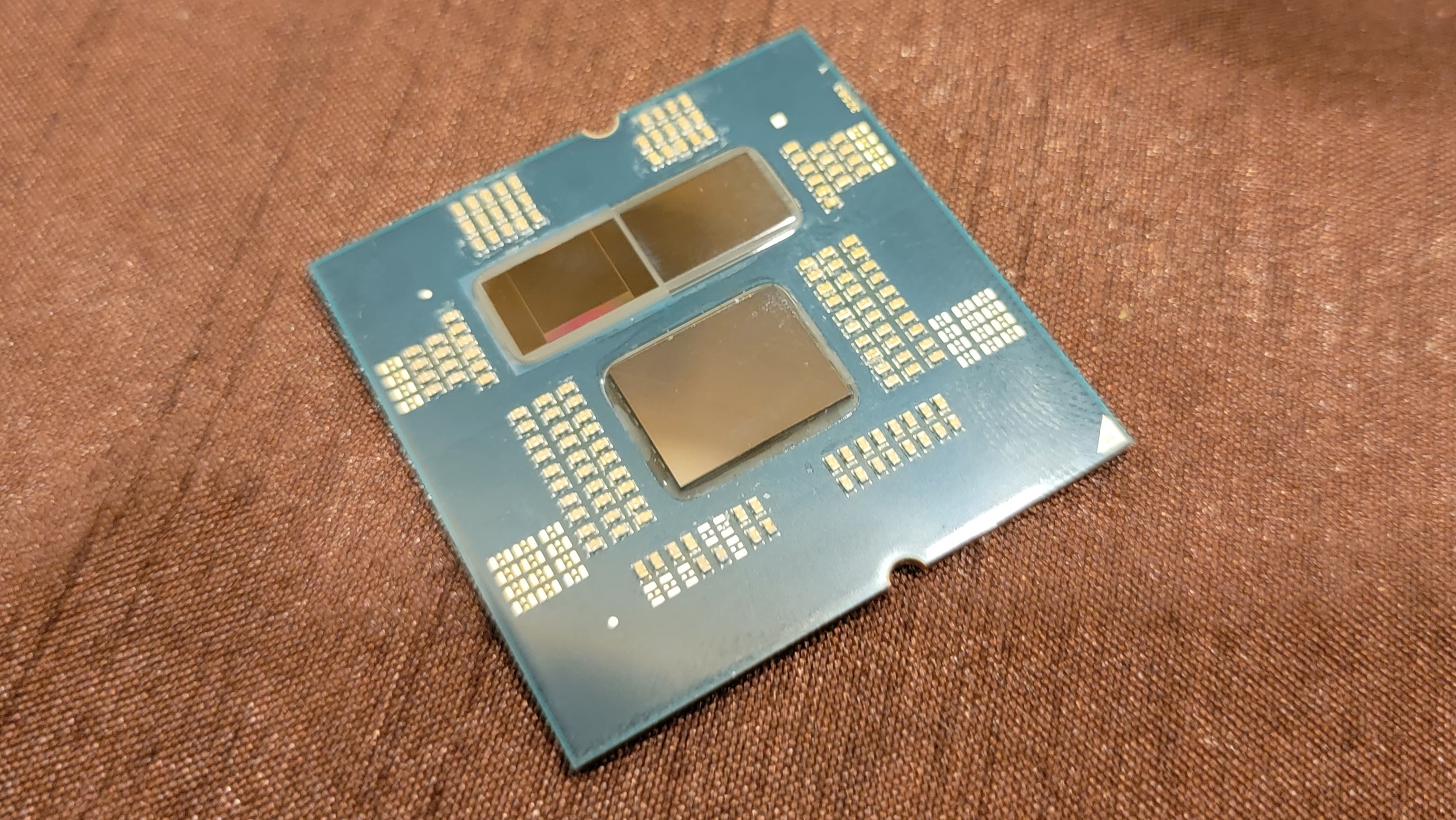AMD Unveils Three Ryzen 7000X3D V-Cache Chips, Three New 65W Non-X CPUs, Too
3D V-Cache to the masses.
AMD announced six new Zen 4 Ryzen 7000 processors for its AM5 platform here at CES 2023 today, with three new high-end Ryzen 7000X3D processors leading the charge with the company’s revolutionary 3D V-Cache in chips that top out at an incredible 5.7 GHz. This now-proven tech should allow AMD to snatch the top spot in our list of best CPUs for gaming and our CPU benchmark hierarchy from Intel’s potent Raptor Lake when they arrive in February.
The new high-performance AMD chips come in 8-, 16- and 24-core flavors, significantly expanding the lineup of 3D V-Cache chips over the single Ryzen 7 5800X3D model that arrived with the first-gen chips. AMD claims explosive generational performance gains with these new chips, saying they will beat Intel’s fastest gaming chip by up to 24% in some games.
| Price | Cores / Threads (P+E) | P-Core Base / Boost Clock (GHz) | Cache (L2/L3) | TDP / PBP / MTP | |
|---|---|---|---|---|---|
| Ryzen 9 7950X3D | ? | 16 / 32 | 4.2 / 5.7 | 144MB (16+128) | 120W / ? |
| Ryzen 9 7900X3D | ? | 12 / 24 | 4.4 / 5.6 | 140MB (12+132) | 120W / ? |
| Ryzen 9 7900 | $429 | 12 / 24 | ? / 5.3 | 76MB (12+64) | 65W / 88W |
| Ryzen 7 7800X3D | ? | 8 /16 | 4.x / 5.0 | 104MB (8+96) | 120W / ? |
| Ryzen 7 5800X3D | $358 | 8 /16 | 3.4 / 4.5 | 104MB (8+96) | 105W |
| Ryzen 7 7700 | $329 | 8 / 16 | ? / 5.3 GHz | 40MB (8+32) | 65W / 88W |
| Ryzen 5 7600 | $229 | 6 / 12 | ? / 5.1 GHz | 38MB (6+32) | 65W / 88W |
The high-performance X3D chips will come at a premium, but AMD also announced three new 65W Ryzen 7000 “non-X” models that span the Ryzen 5 to Ryzen 9 families, thus providing a new lower level of entry to the AM5 platform to address some of the pricing issues associated with the company’s new AM5 platform. These chips will arrive on January 10. AMD shared plenty of new details and benchmarks during its CES 2023 keynote; let’s dive in.
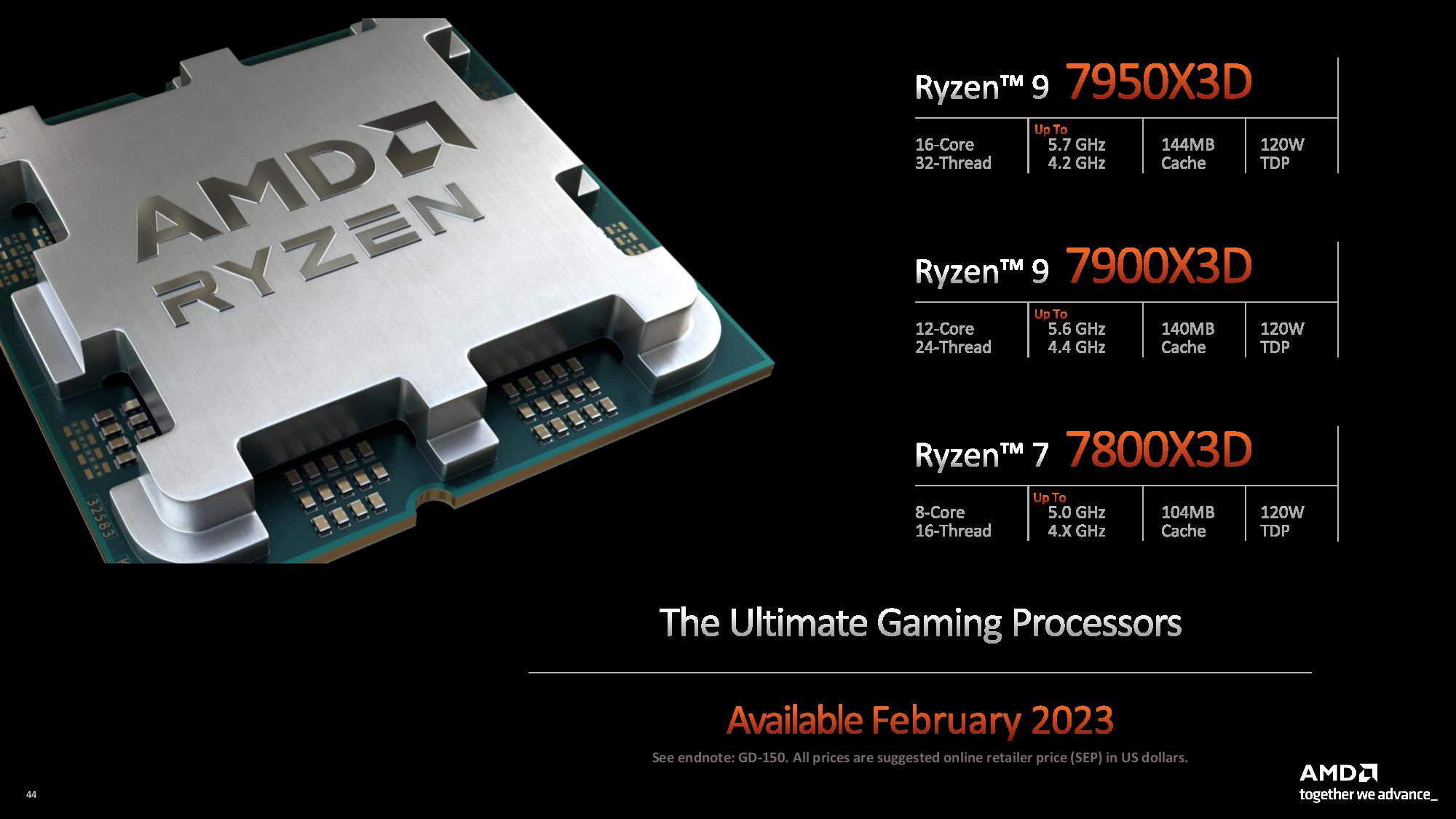
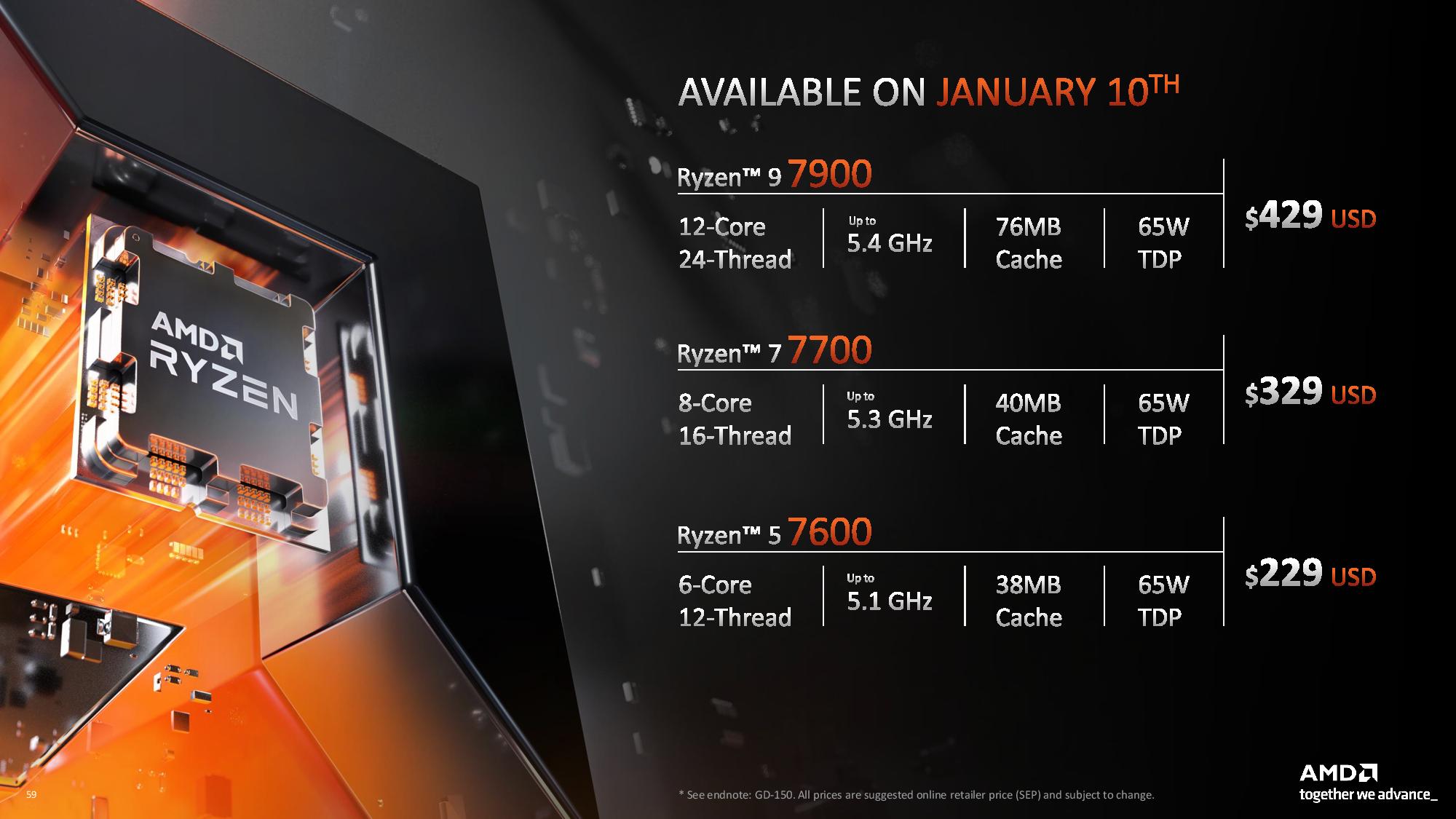

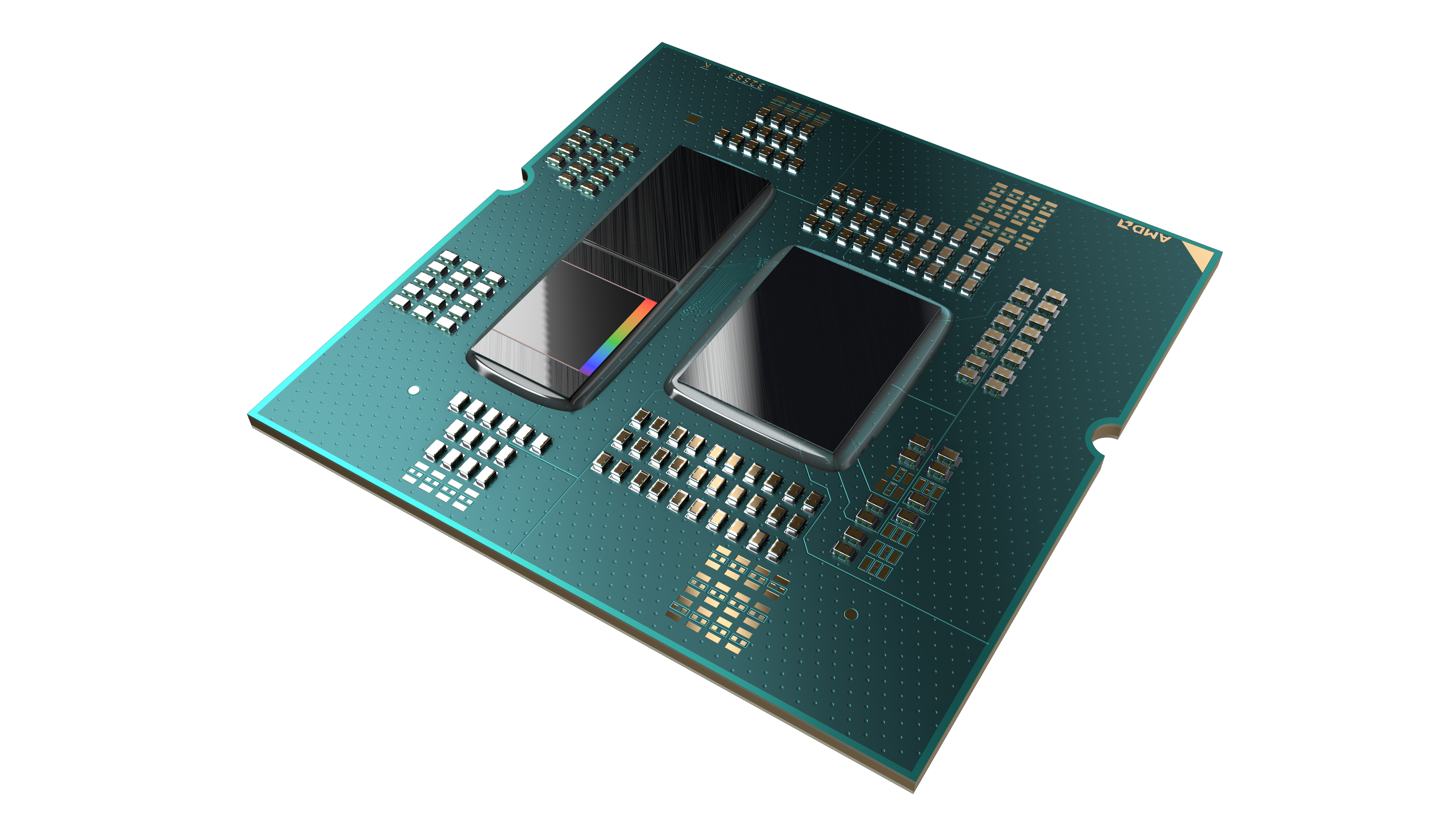
AMD Ryzen 9 7950X3D, Ryzen 7 7900X3D, Ryzen 7 7800X3D Specifications
| Street/MSRP | Cores / Threads (P+E) | P-Core Base / Boost Clock (GHz) | E-Core Base / Boost Clock (GHz) | Cache (L2/L3) | TDP / PBP / MTP | Memory | |
|---|---|---|---|---|---|---|---|
| Ryzen 9 7950X3D | ? | 16 / 32 | 4.2 / 5.7 | 144MB (16+128) | 120W / ? | DDR5-5200 | |
| Core i9-13900K / KF | $589 (K) - $564 (KF) | 24 / 32 (8+16) | 3.0 / 5.8 | 2.2 / 4.3 | 68MB (32+36) | 125W / 253W | DDR4-3200 / DDR5-5600 |
| Ryzen 9 7950X | $569 ($699) | 16 / 32 | 4.5 / 5.7 | - | 80MB (16+64) | 170W / 230W | DDR5-5200 |
| Ryzen 9 7900X3D | ? | 12 / 24 | 4.4 / 5.6 | 140MB (12+132) | 120W / ? | DDR5-5200 | |
| Ryzen 9 7900X | $474 ($549) | 12 / 24 | 4.7 / 5.6 | - | 76MB (12+64) | 170W / 230W | DDR5-5200 |
| Core i7-13700K / KF | $409 (K) - $384 (KF) | 16 / 24 (8+8) | 3.4 / 5.4 | 2.5 / 4.2 | 54MB (24+30) | 125W / 253W | DDR4-3200 / DDR5-5600 |
| Core i7-13700 / F | $384 - $359 (F) | 16 / 24 (8+8) | 2.1 / 5.2 | 1.5 / 4.1 | 54MB (24+30) | 65W / 219W | DDR4-3200 / DDR5-5600 |
| Ryzen 7 7800X3D | ? | 8 /16 | 4.x / 5.0 | 104MB (8+96) | 120W / ? | DDR5-5200 | |
| Ryzen 7 5800X3D | $358 ($449) | 8 /16 | 3.4 / 4.5 | 104MB (8+96) | 105W | DDR4-3200 | |
| Ryzen 7 7700X | $349 ($399) | 8 /16 | 4.5 / 5.4 | - | 40MB (8+32) | 105W / 142W | DDR5-5200 |
| Ryzen 5 7600X | $249 ($299) | 6 / 12 | 4.7 / 5.3 | - | 38MB (6+32) | 105W / 142W | DDR5-5200 |
| Core i5-13600K / KF | $319 (K) - $294 (KF) | 14 / 20 (6+8) | 3.5 / 5.1 | 2.6 / 3.9 | 44MB (20+24) | 125W / 181W | DDR4-3200 / DDR5-5600 |
As a reminder, AMD’s 3D V-Cache is a revolutionary new tech that 3D-stacks an additional SRAM chip vertically on top of the processor, thus boosting the L3 cache capacity by 64MB and enabling explosive performance gains in gaming (productivity workloads don’t benefit). This tech debuted in AMD’s Ryzen 7 5800X3D, the first ‘X3D’ model, which you can read the deep dive details about here. Intel doesn’t have a comparable technology, though it will soon bring the 6 GHz Core i9-13900KS to market in an attempt to hold onto its gaming crown.
AMD hasn’t shared pricing information for the new X3D chips, but says they will arrive in February. The Ryzen 9 7950X3D comes with 16 cores and 32 threads, marking a new high count for the 3D V-Cache-equipped chips. In effect, this chip is merely a Ryzen 9 7950X with an extra L3 cache chiplet and additional tuning. As before, the 3D-stacked SRAM L3 chip weighs in at 64MB, so the 7950X3D comes with a beastly 144MB of total cache, with 128MB of that being gaming-boosting L3 cache. This chip will contend with Intel’s Core i9-13900K, and soon the 6 GHz 13900KS model.
AMD has spec’d the 3D V-Cache processors at a base TPD of 120W and a max 162W PPT, which is lower than the standard 170W/230W threshold for the 7950X. That isn’t entirely surprising, as the additional cache chiplet can result in slightly higher operating temperatures. However, AMD has significantly increased the boost speeds with the new X3D models. As a result, the 7950X3D boosts to 5.7 GHz, a vast leap over the previous gen 5800X3D’s peak of 4.5 GHz and the same as the standard 7950X. We do see a slight decline of 200 MHz compared to the 7950X, a necessary accommodation for the lower 120W TDP.
The previous-gen model’s performance famously suffers in standard applications due to its lower boost clock rate, so the 7950X3D’s higher clock rate implies that we won’t see as much of a tradeoff in productivity apps with the new Zen 4 models. However, we are looking at a 50W reduction in available power, which will have an impact on threaded workloads.
Get Tom's Hardware's best news and in-depth reviews, straight to your inbox.
In fact, frequencies are higher for all three new X3D chips. The 12-core 24-thread Ryzen 9 7900X3D peaks at 5.6 GHz, the same as the standard 7900X, while base clocks decline a relatively minor 300 MHz (it’s rare to see the base clock in actual use). This chip comes armed with 104MB of cache, with 96 MB carved out as L3. This chip also drops to the lower 120W TDP range, so it will also lose some performance in heavily-threaded applications.
Both the 7950X3D and the 7900X3D have two four-core chiplets, marking the first time that AMD has brought this tech to a multi-CCD processor. As you can see in the above image, AMD only mounts a single SRAM chiplet atop one CCD, leaving the other CCD bare. This allows the chiplet without the 3D-stacked SRAM to operate at full speed, thus delivering the high boost clocks we see on the spec sheet. Meanwhile, the SRAM-stacked CCD will operate at a slightly lower clock rate than the rated boost for the chip.
AMD is working with Microsoft on Windows optimizations that will work in tandem with a new AMD chipset driver to identify games that prefer the increased L3 cache capacity and pin them into the CCD with the stacked cache. Other games that prefer higher frequencies more than increased L3 cache will be pinned into the bare CCD. AMD says that the bare chiplet can access the stacked L3 cache in the adjacent chiplet, but this isn’t optimal and will be rare. Yes, the chip with the extra L3 cache will run games at a slower speed, but most games don’t operate at peak clock rates, so you should still get a huge performance benefit.
The Ryzen 7 7800X3D comes as the only 7800X model in the stack, so there isn’t a direct comparison from AMD’s Zen 4 stable. However, it is directly comparable to the first-gen Ryzen 7 5800X3D. The 8-core 16-thread 7800X3D has 96MB of L3 cache, the same core count and cache capacity as its Zen 3 predecessor. The 7800X3D also has a base clock of 4.x and a 5.0 GHz boost, both of which are higher than the 5800X3D’s 3.4 GHz base and 4.5 GHz boost. Like the other X3D chips, the 7800X3D has a 120W TDP, which is 15W higher than the 5800X3D and the current-gen eight-core Ryzen 7 7700X. Those faster clocks and higher TDP paired with the more modern Zen 4 architecture will yield performance boosts over the 5800X3D and the 7700X alike. It’s logical to think that this chip should offer the lion’s share of the gaming benefits you’ll see with the X3D chips, so we expect this to be a popular model.
AMD’s only allowed overclocking the memory and infinity fabric for the previous-gen 5800X3D, not other forms of core overclocking, but will now allow both the auto-overclocking Precision Boost Overdrive (PBO) and use of the Curve Optimizer. AMD tells us that the Curve Optimizer will work best to extract more performance, but both options are available. However, AMD will not allow direct frequency overclocking due to a 1.4V limit for the chip (this was a 1.1V limit with the previous-gen model).
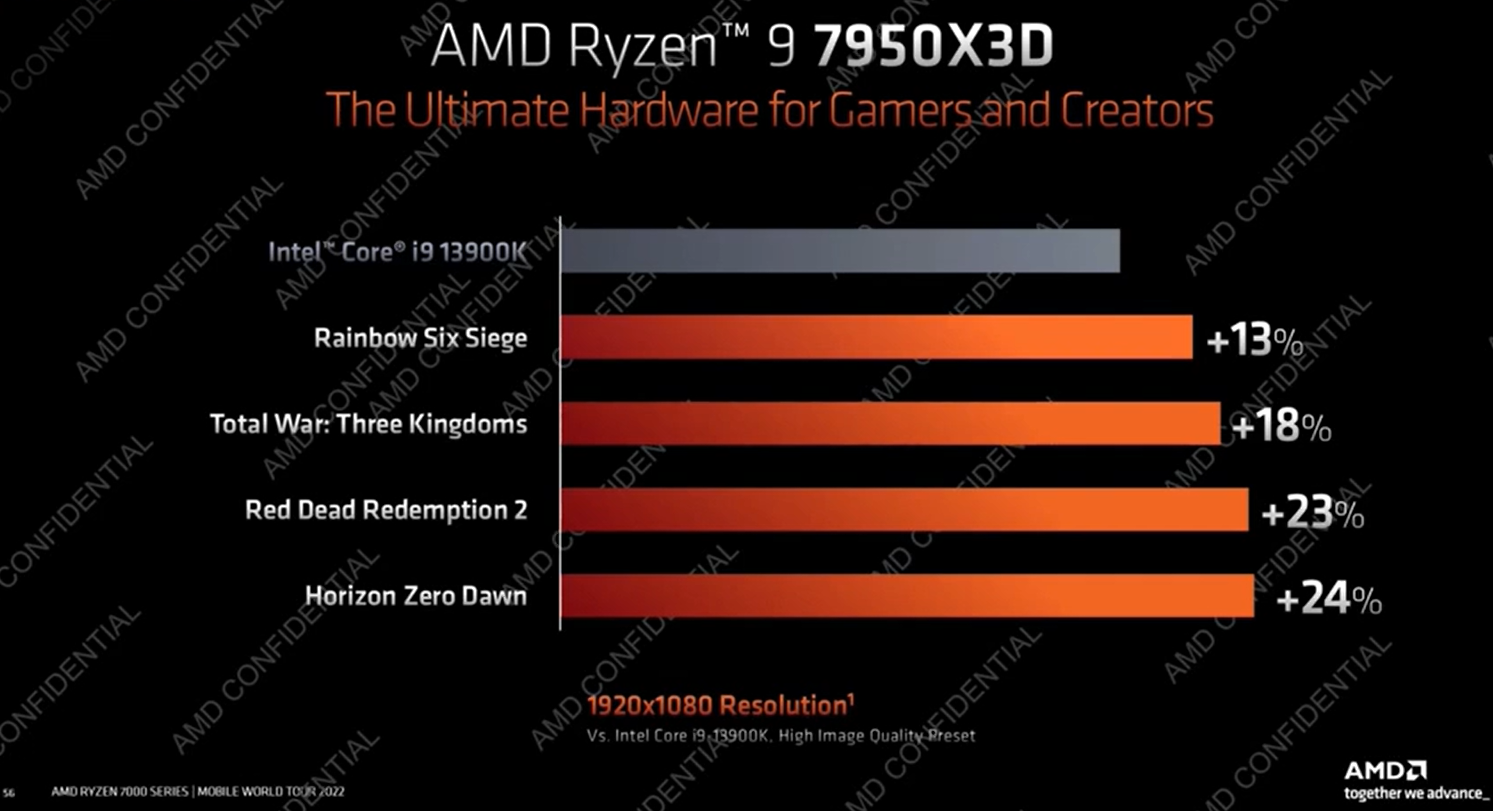
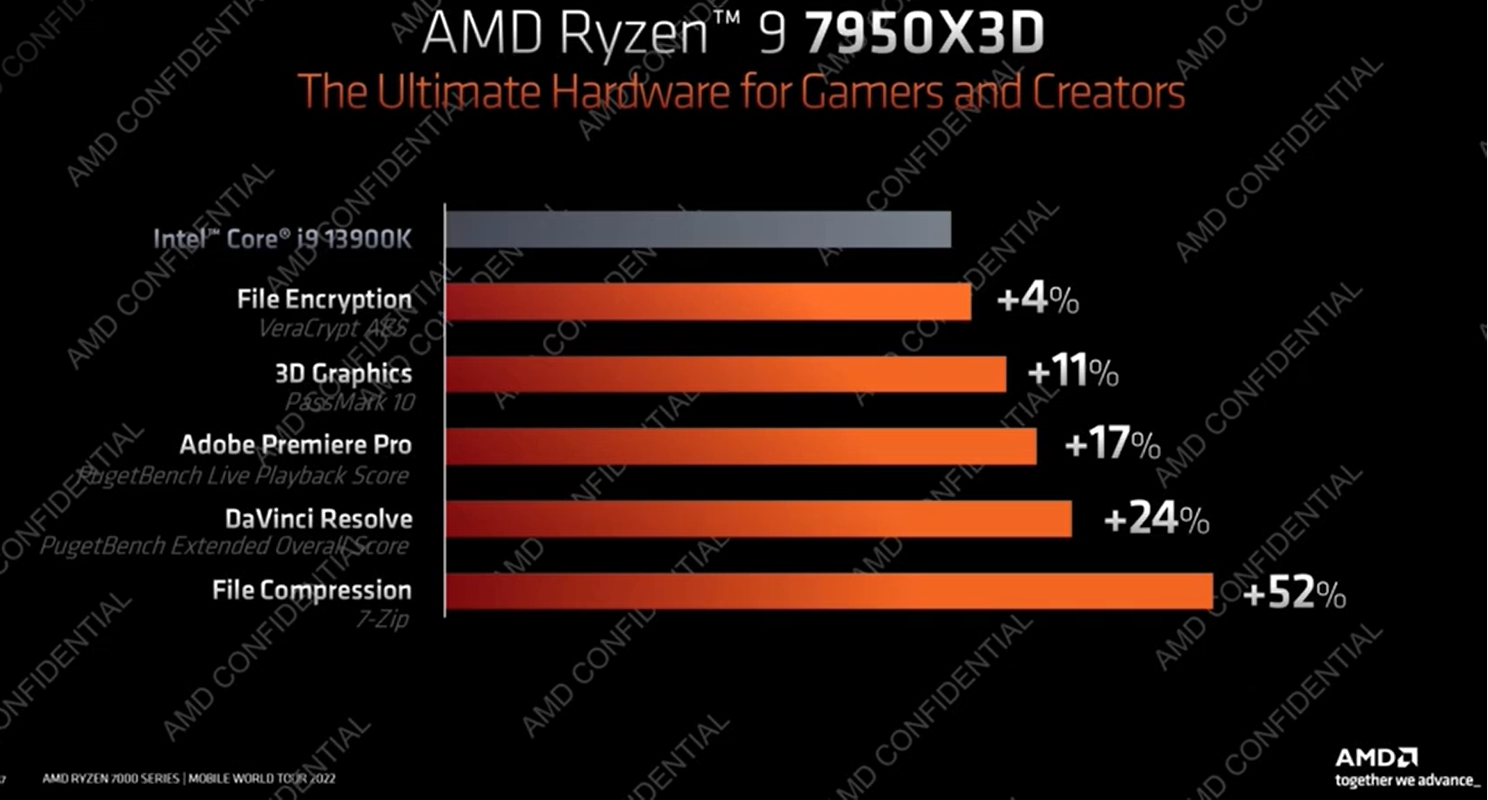
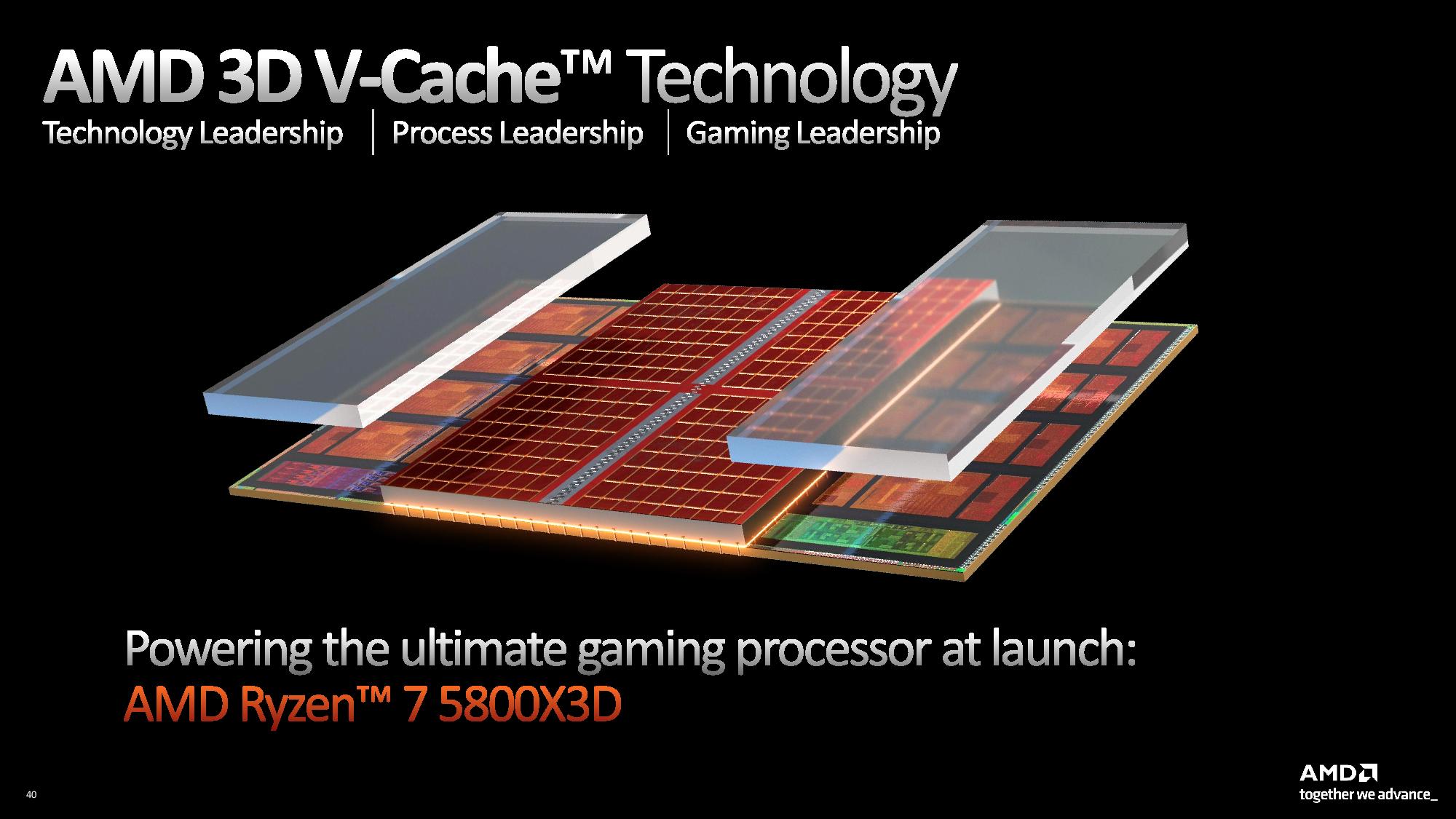
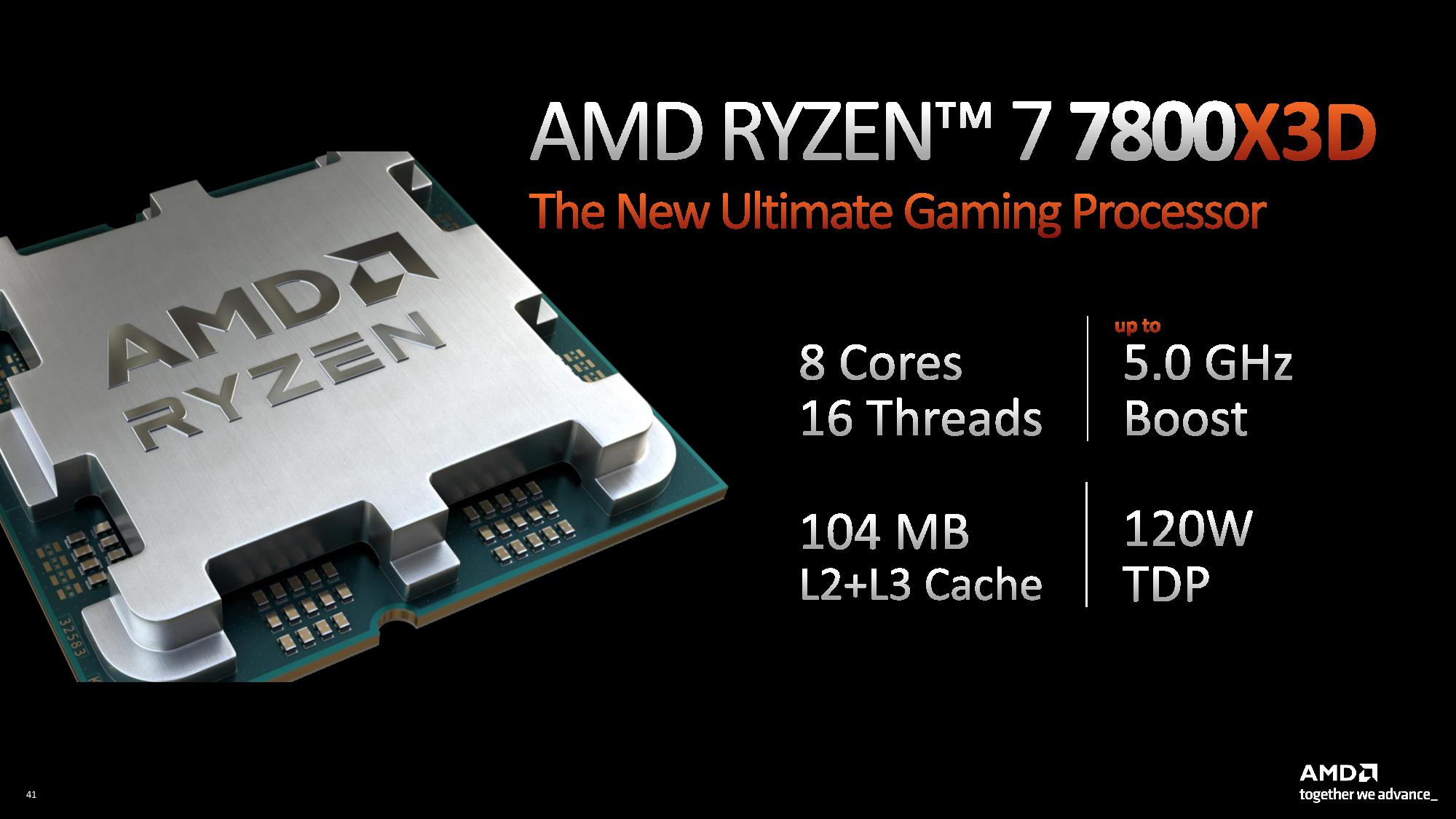
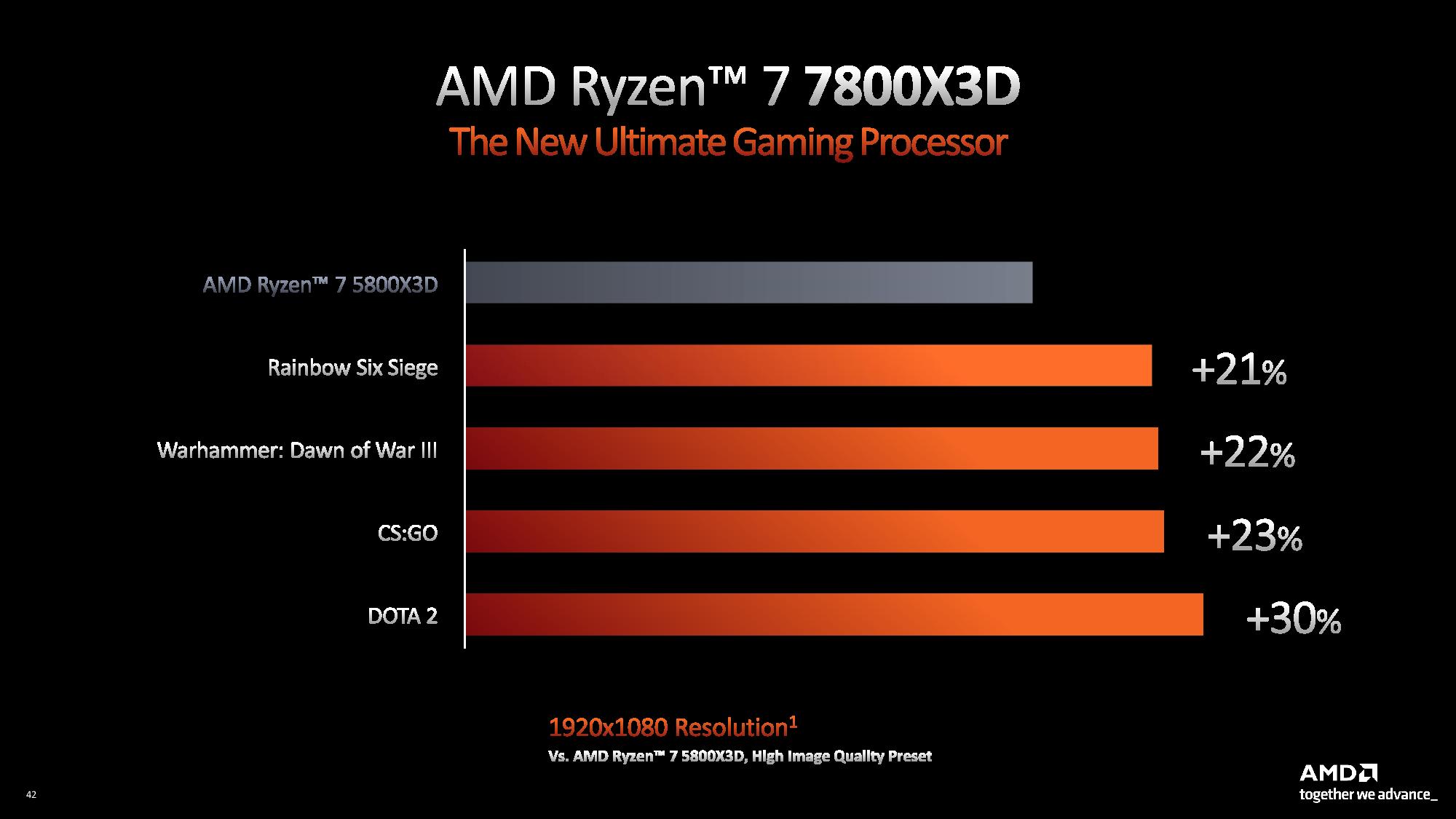
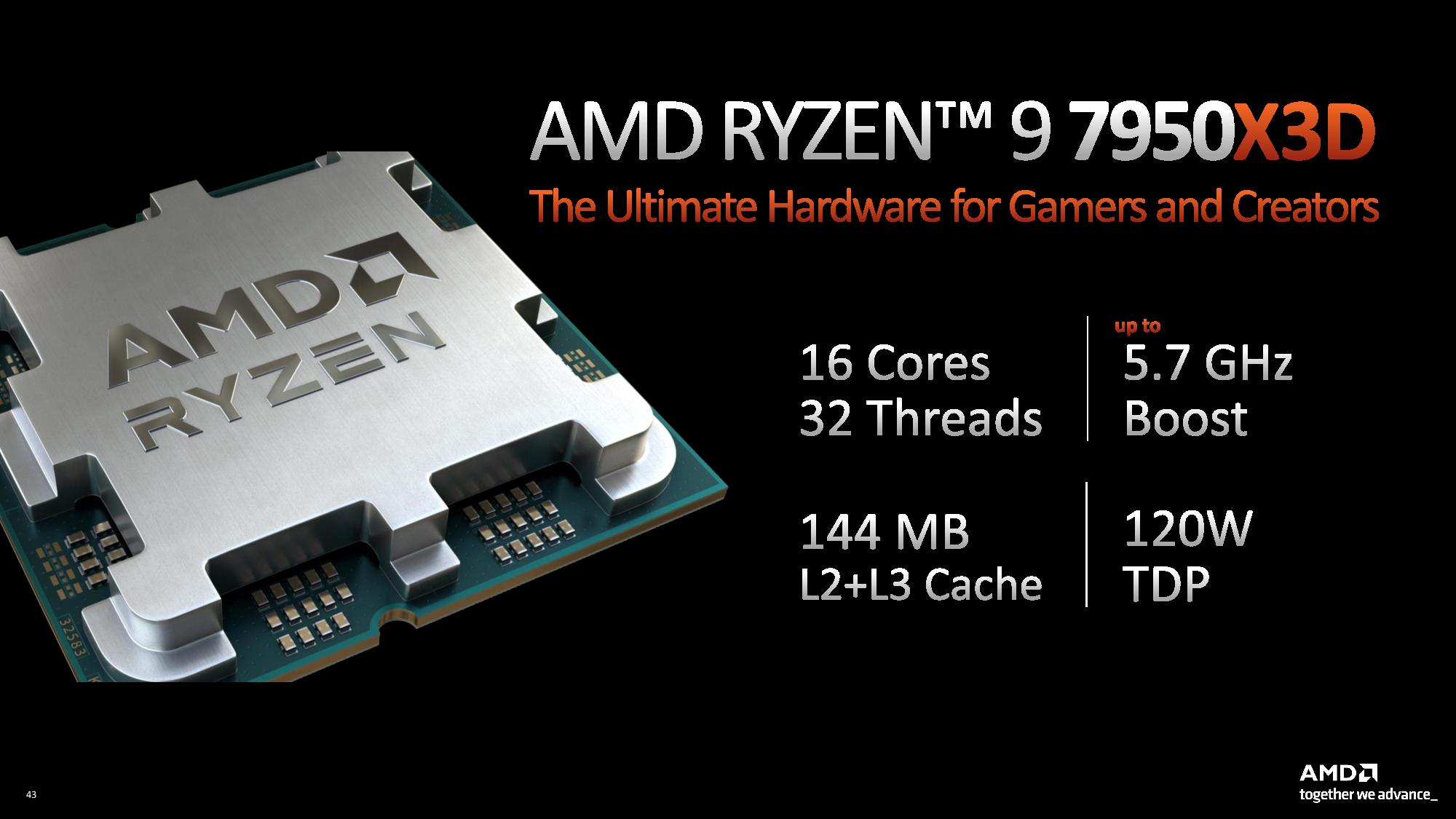
AMD shared some performance benchmarks, but as with all third-party tests, take them with a grain of salt. These charts also include an unlabeled axis, so it could also be a non-zero axis that visually inflates performance deltas.
AMD showed performance results in dour titles that are often CPU bound, so the benefits of the X3D architecture shine through – particularly at the 1080p resolution used for testing. AMD claims the beastly 16-core 7950X3D is anywhere from 13% to 24% faster than the Intel flagship Core i9-13900K in these titles. The Ryzen 7 5800X3D is a wonderful gaming processor, but it suffers tremendously in application benchmarks. That tradeoff appears to be drastically reduced with the 7950X3D, as AMD claims that it is anywhere from 4% to 52% faster than the Core i9-13900K in a selection of productivity benchmarks.
The Ryzen 7 7800X3D also appears potent, with AMD’s benchmarks showing it anywhere from 21% to 30% faster than the 5800X3D in this selection of titles. Be aware that there are a few esports class titles in this selection, and that some games will either not benefit from the extra cache as much, or not benefit at all.
AMD Ryzen 9 7900, Ryzen 7 7700, Ryzen 5 7600 Pricing and Specifications
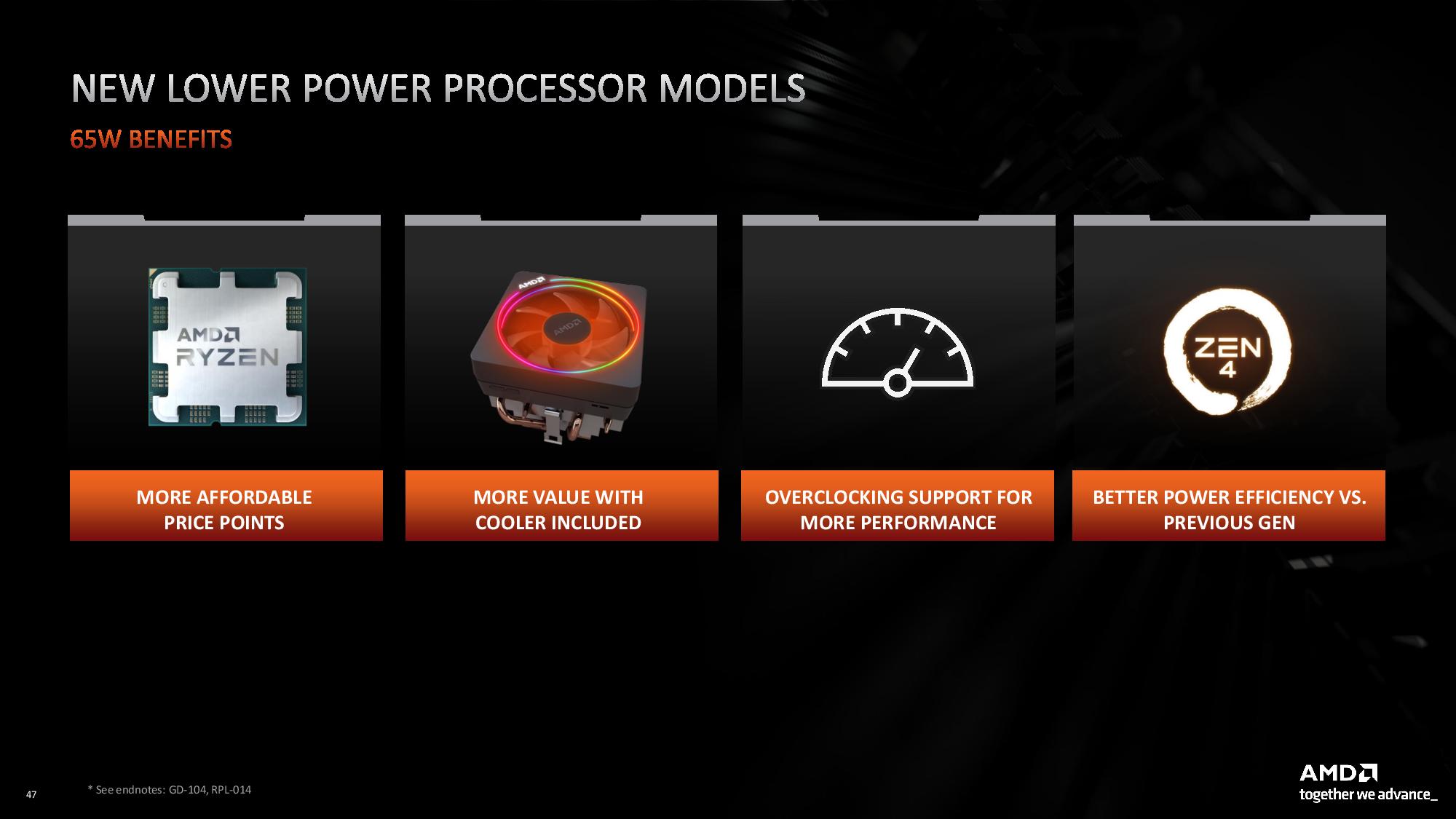
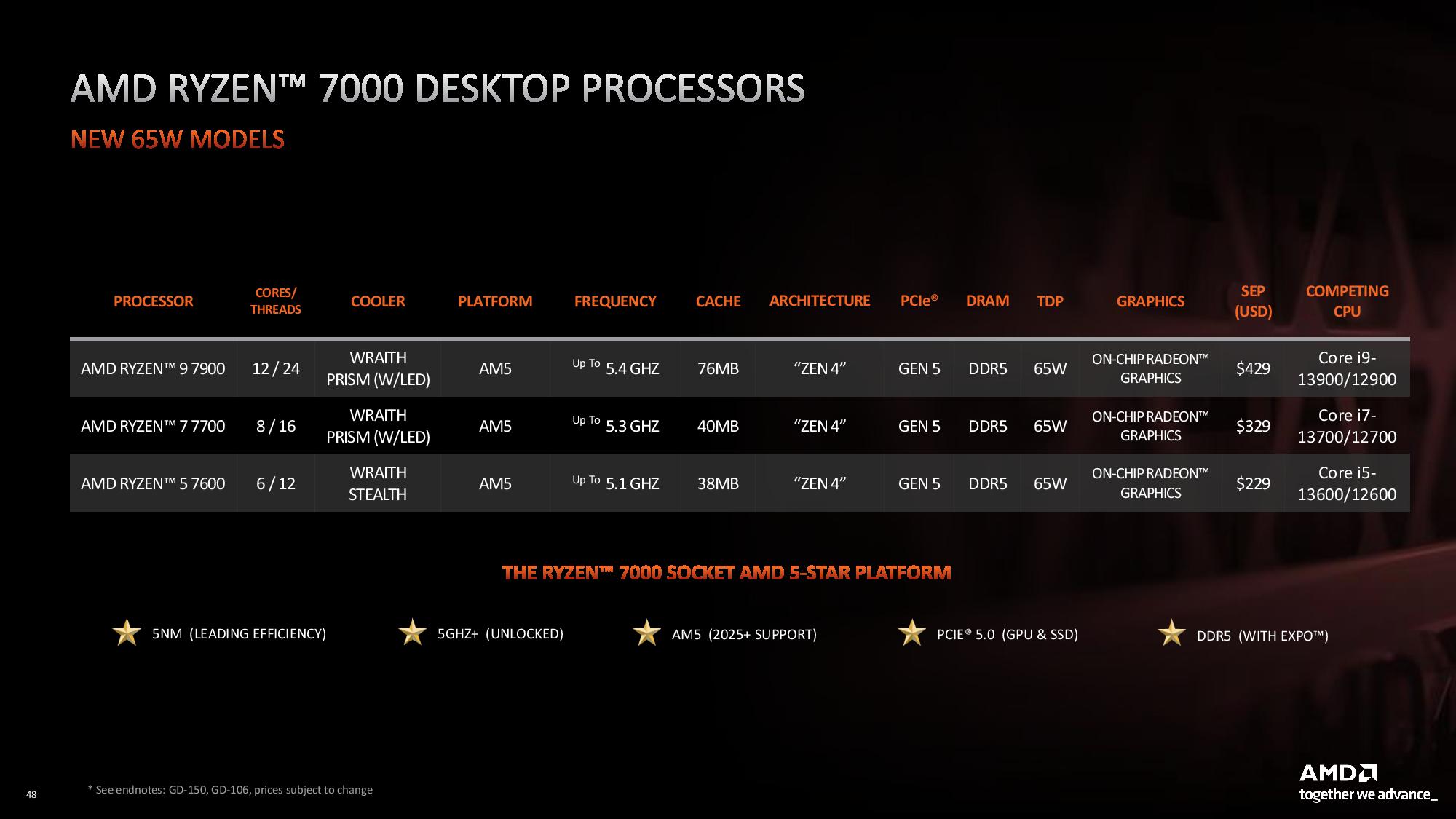
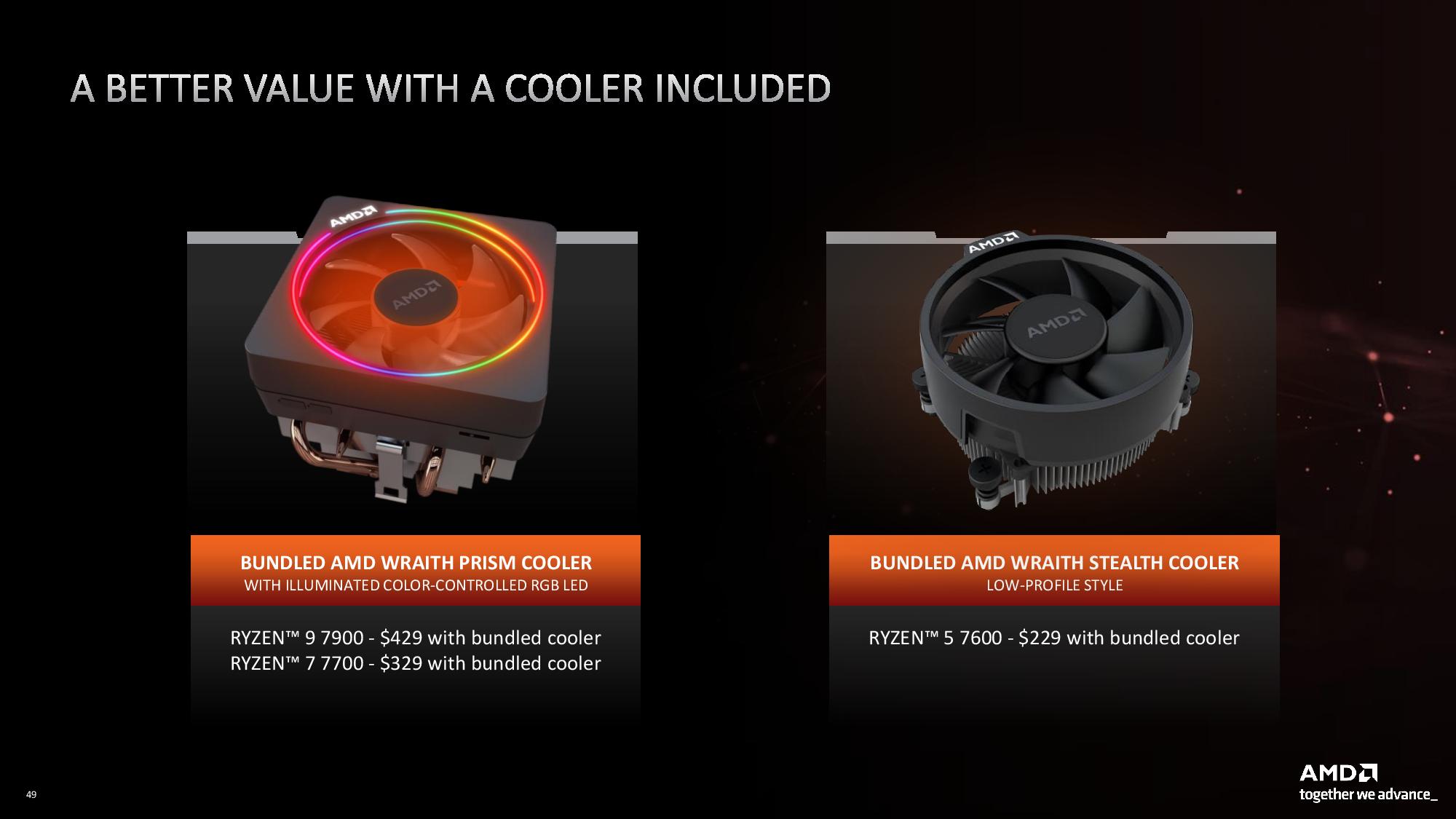
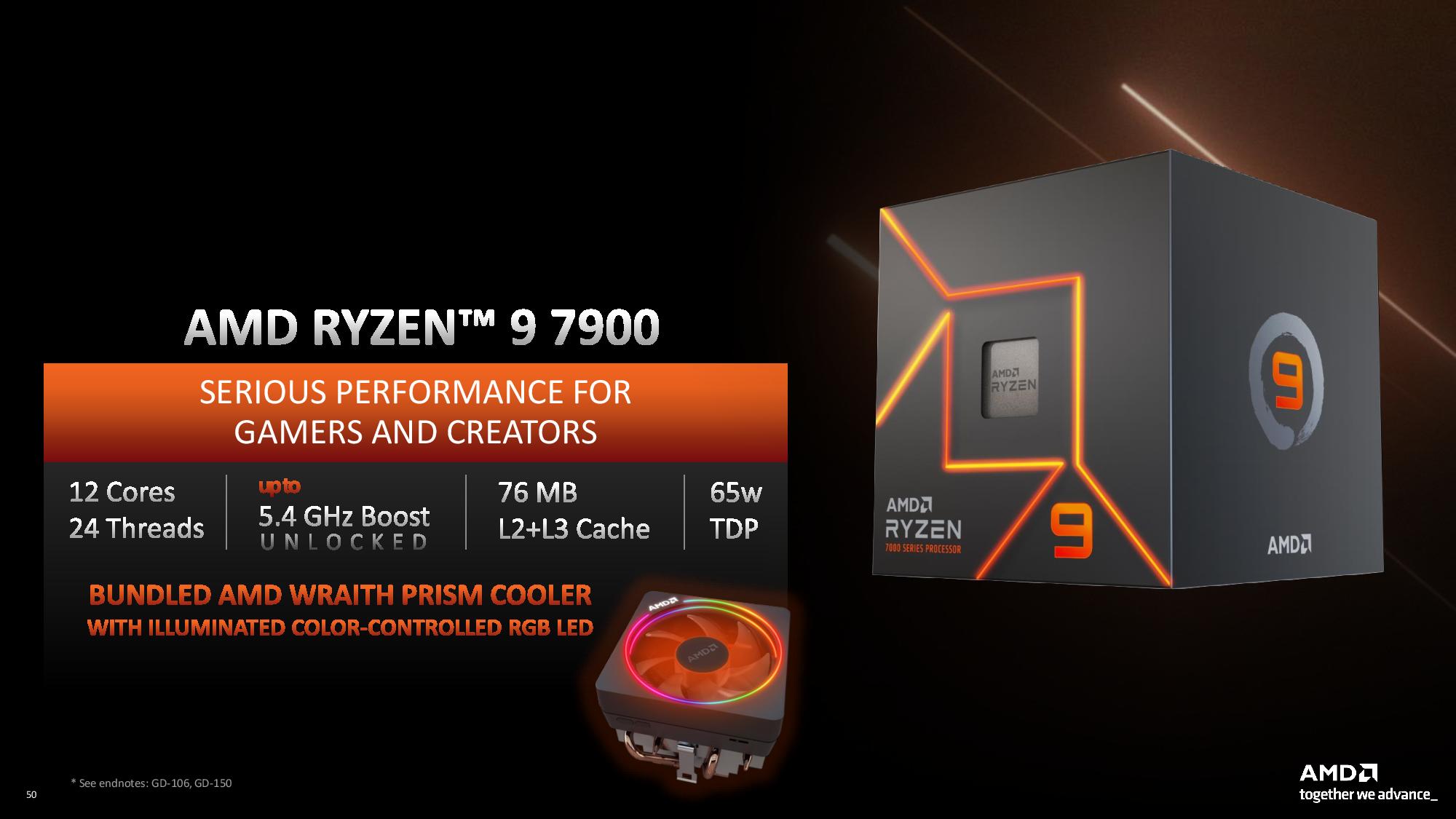
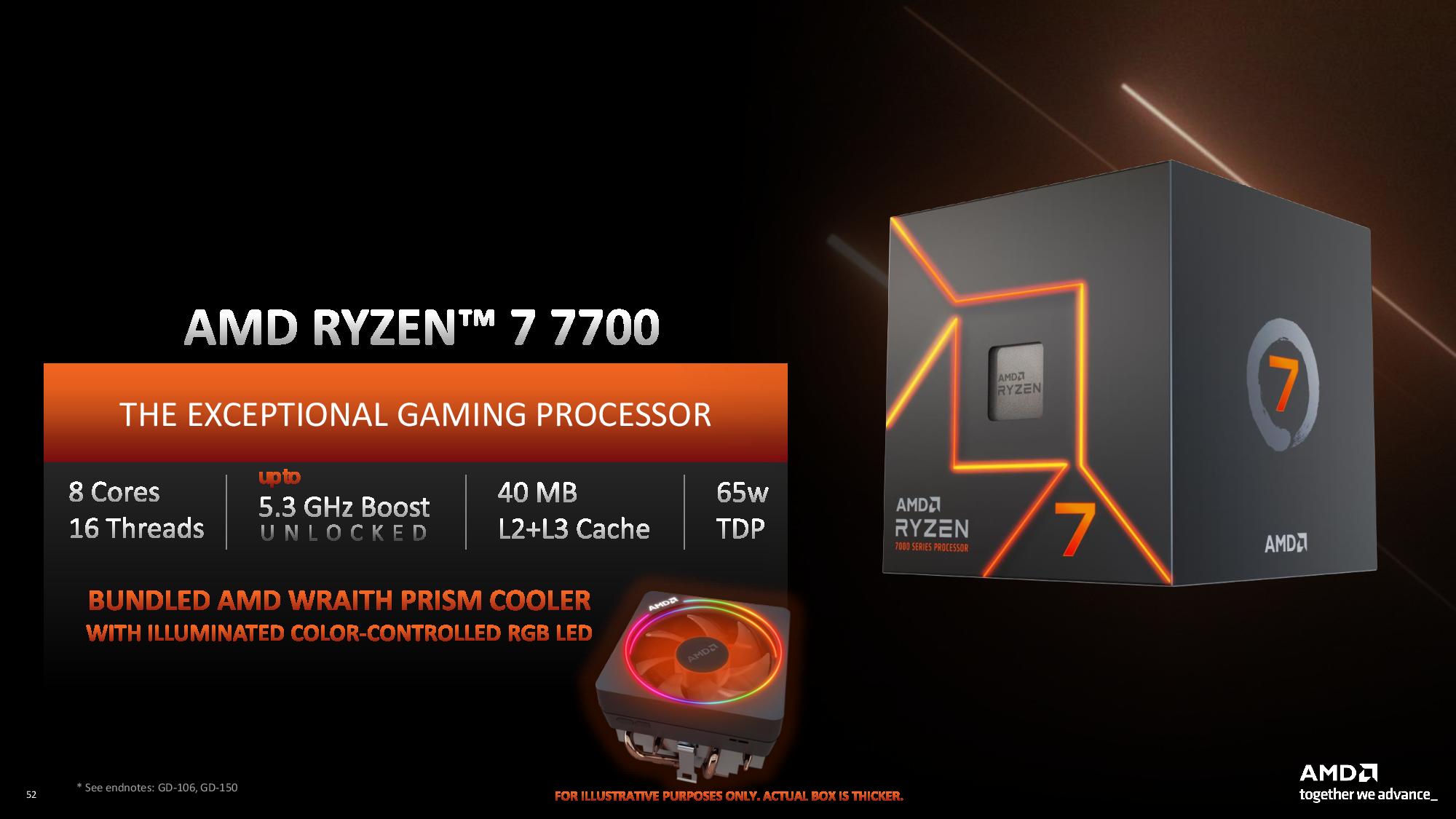
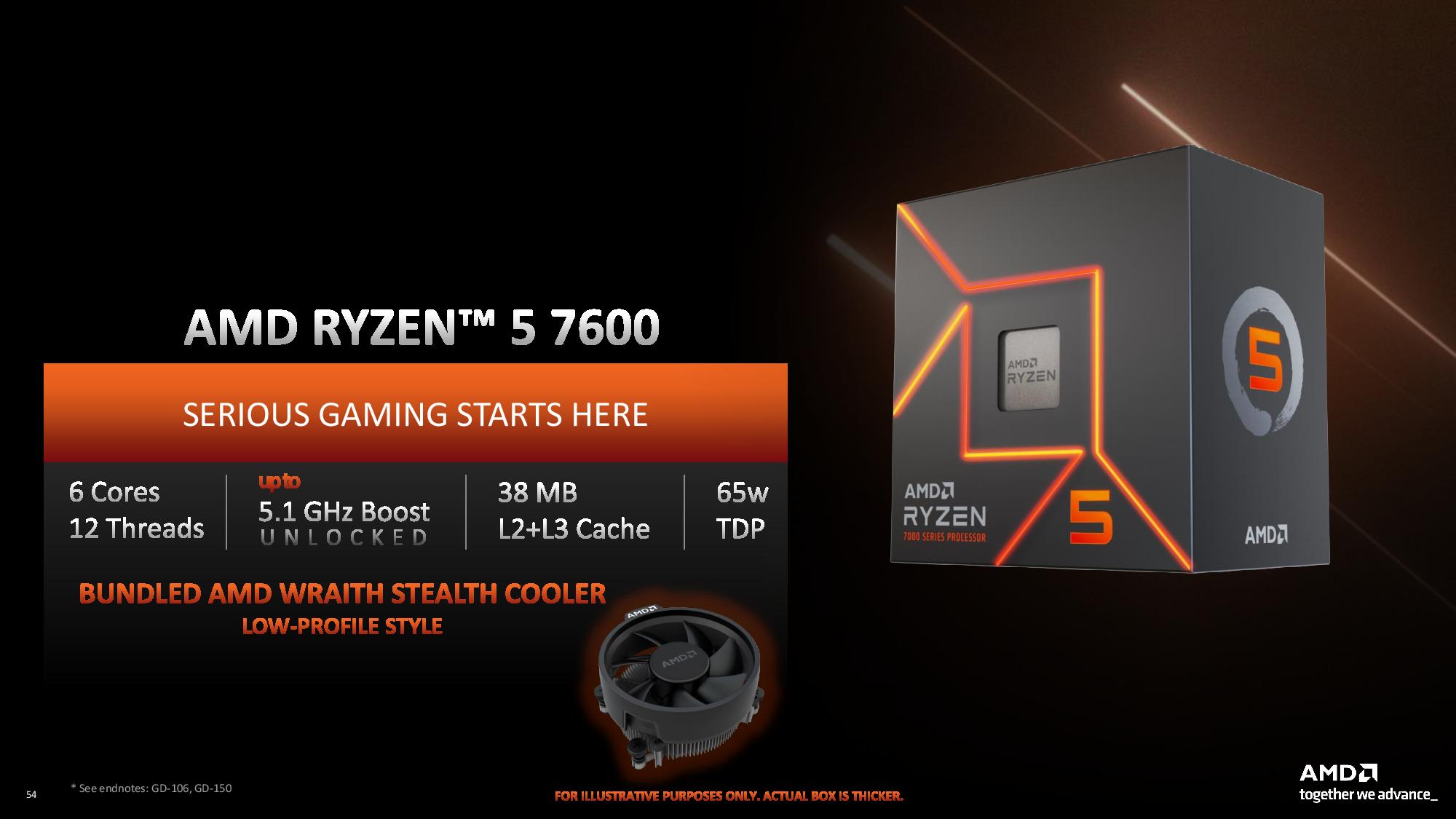
The 65W “non-X” Zen 4 Ryzen models are long awaited by value seekers, as they provide a lower cost of entry to the AM5 platform – a much needed addition given the high cost of AM5 motherboards and the fact that Ryzen 7000 requires pricey DDR5 memory while Intel’s chips can support either DDR4 or DDR5, thus giving it an overall cost advantage. Additionally, the chips come with bundled coolers that significantly improve the value proposition, and simply engaging the auto-overclocking Precision Boost Overdrive (PBO) feature in tandem with memory overclocking can yield nearly the same result as the X-series models. All of the new models have a 65W base power and 88W limit under full load.
| Street/MSRP | Cores / Threads (P+E) | P-Core Base / Boost Clock (GHz) | E-Core Base / Boost Clock (GHz) | Cache (L2/L3) | TDP / PBP / MTP | Memory | |
|---|---|---|---|---|---|---|---|
| Core i9-13900 / F | $549 - $529 (F) | 24 / 32 (8+16) | 2.0 / 5.6 | 1.5 / 4.2 | 68MB (32+36) | 65W / 219W | DDR4-3200 / DDR5-5600 |
| Ryzen 9 7900X | $474 ($549) | 12 / 24 | 4.7 / 5.6 | - | 76MB (12+64) | 170W / 230W | DDR5-5200 |
| Ryzen 9 7900 | $429 | 12 / 24 | ? / 5.3 | 76MB (12+64) | 65W / 88W | DDR5-5200 | |
| Core i7-13700K / KF | $409 (K) - $384 (KF) | 16 / 24 (8+8) | 3.4 / 5.4 | 2.5 / 4.2 | 54MB (24+30) | 125W / 253W | DDR4-3200 / DDR5-5600 |
| Core i7-13700 / F | $384 - $359 (F) | 16 / 24 (8+8) | 2.1 / 5.2 | 1.5 / 4.1 | 54MB (24+30) | 65W / 219W | DDR4-3200 / DDR5-5600 |
| Ryzen 7 7700X | $349 ($399) | 8 /16 | 4.5 / 5.4 | - | 40MB (8+32) | 105W / 142W | DDR5-5200 |
| Ryzen 7 7700 | $329 | 8 / 16 | ? / 5.3 GHz | 40MB (8+32) | 65W / 88W | DDR5-5200 | |
| Ryzen 5 7600X | $249 ($299) | 6 / 12 | 4.7 / 5.3 | - | 38MB (6+32) | 105W / 142W | DDR5-5200 |
| Ryzen 5 7600 | $229 | 6 / 12 | ? / 5.1 GHz | 38MB (6+32) | 65W / 88W | DDR5-5200 | |
| Core i5-13600K / KF | $319 (K) - $294 (KF) | 14 / 20 (6+8) | 3.5 / 5.1 | 2.6 / 3.9 | 44MB (20+24) | 125W / 181W | DDR4-3200 / DDR5-5600 |
| Core i5-13500 | $232 | 14 / 20 (6+8) | 2.5 / 4.8 | 1.8 / 3.5 | 55.5MB (11.5+24) | 65W /148W | DDR4-3200 / DDR5-4800 |
| Core i5-13400 / F | $221 - $196 (F) | 10 / 16 (6+4) | 2.5 / 4.6 | 1.8 / 3.3 | 29.5MB (9.5+20) | 65W /148W | DDR4-3200 / DDR5-4800 |
The $429 Ryzen 9 7900 leads the charge with 12 cores and 24 threads, and you’ll notice there isn’t a non-X 7950X model, so 12 cores is the most you can buy for a reduced-cost 65W chip. AMD isn’t sharing the base frequency for any of the non-X models yet – we expect they’ll be significantly lower than the 7900X to fit within the lower TDP rating - but specs an ‘up to’ 5.4 GHz boost for the 7900. That’s only 300 MHz lower than the $474 Ryzen 9 7900X, which is reasonable considering its lower 65W/88W TDP rating compared to the 7900X’s 170W/230W. The rest of the 7900’s key specifications are identical to the 7900X. The 7900 competes with Intel’s Core i9-13900, but at a significantly lower price point. This chip comes with the capable RGB Wraith Prism cooler.
The Ryzen 7 7700 weighs in with eight cores and twelve threads for $329, which is a small savings compared to the Ryzen 7 7700X’s $349 street price. This chip does come with a bundled cooler while the 7700X does not, but we still expect that the 7700 will soon retail for much less than this suggested pricing. This chip boosts up to 5.1 GHz, a 200 MHz decline from the 7700X. The 7700 also comes with the RGB-equipped Wraith Prism and will compete with the Core i7-13700.
The Ryzen 7 7600 should be the value darling of this generation, just the Ryzen 5 5600 was for the previous-gen Zen 3 lineup. The 7600 has a 5.1 GHz boost, a 200 MHz decline compared to the 7600X, and has a bundled Wraith Stealth cooler. This chip will grapple with Intel’s Core i5-13600.
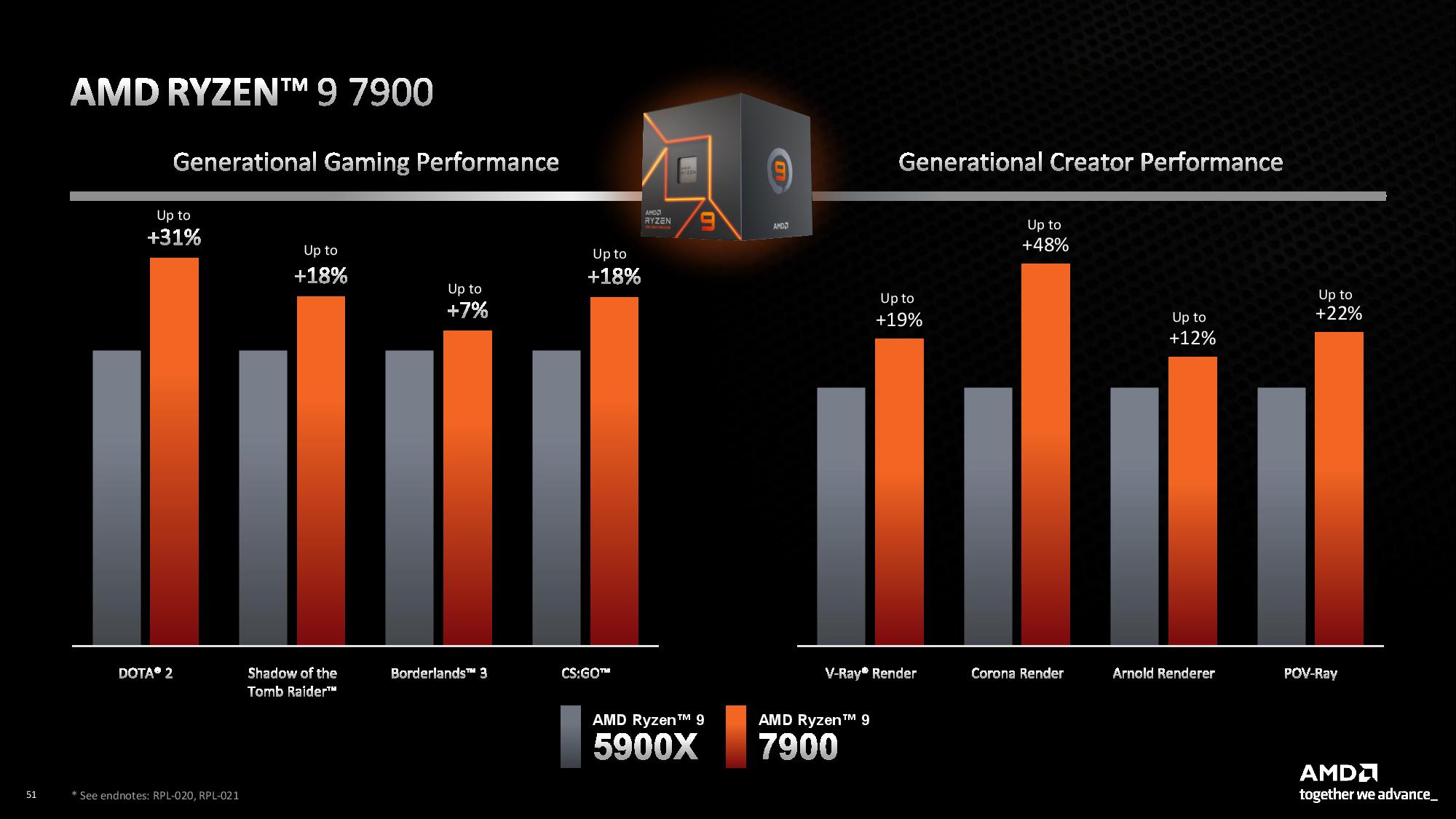
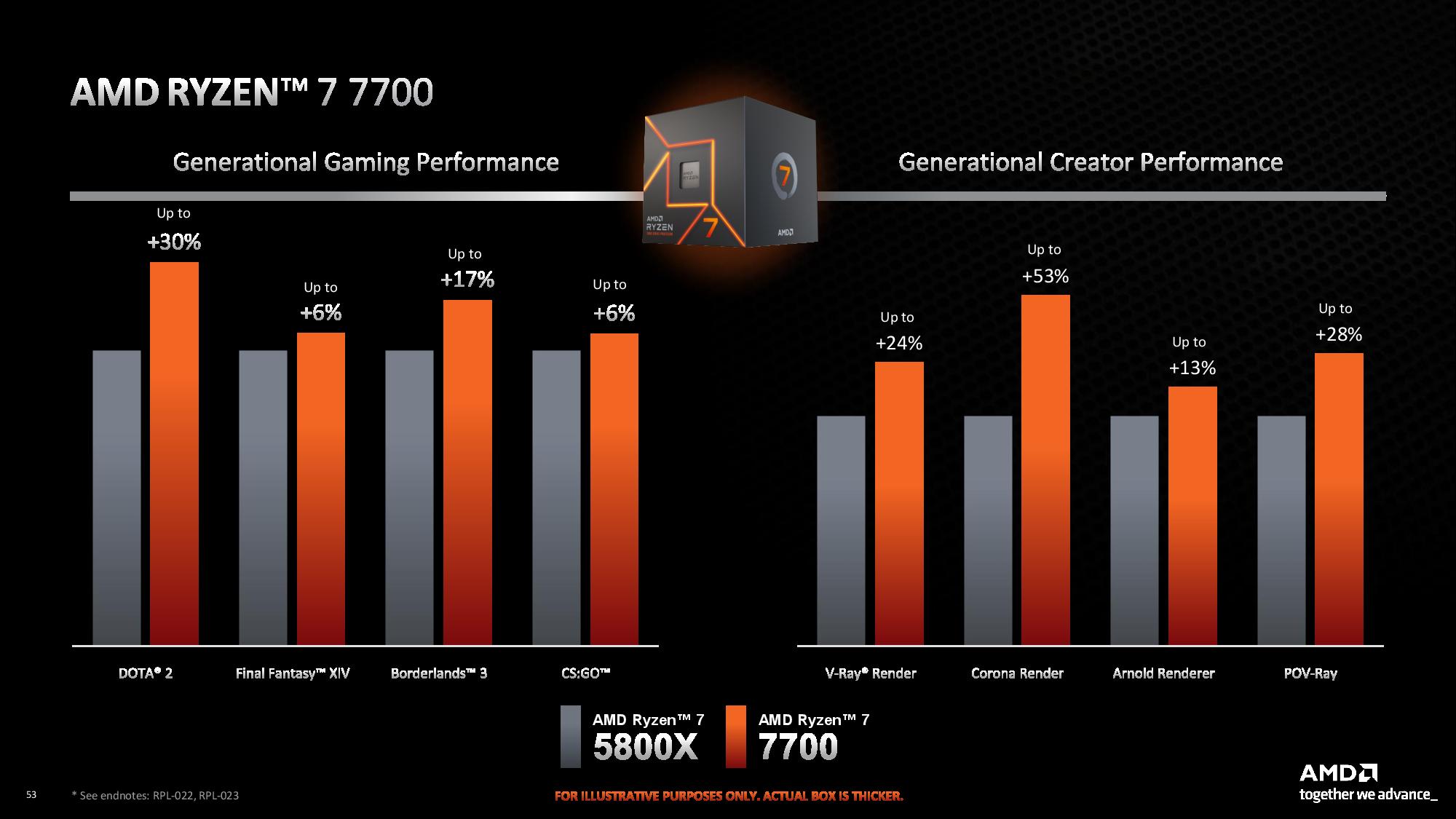
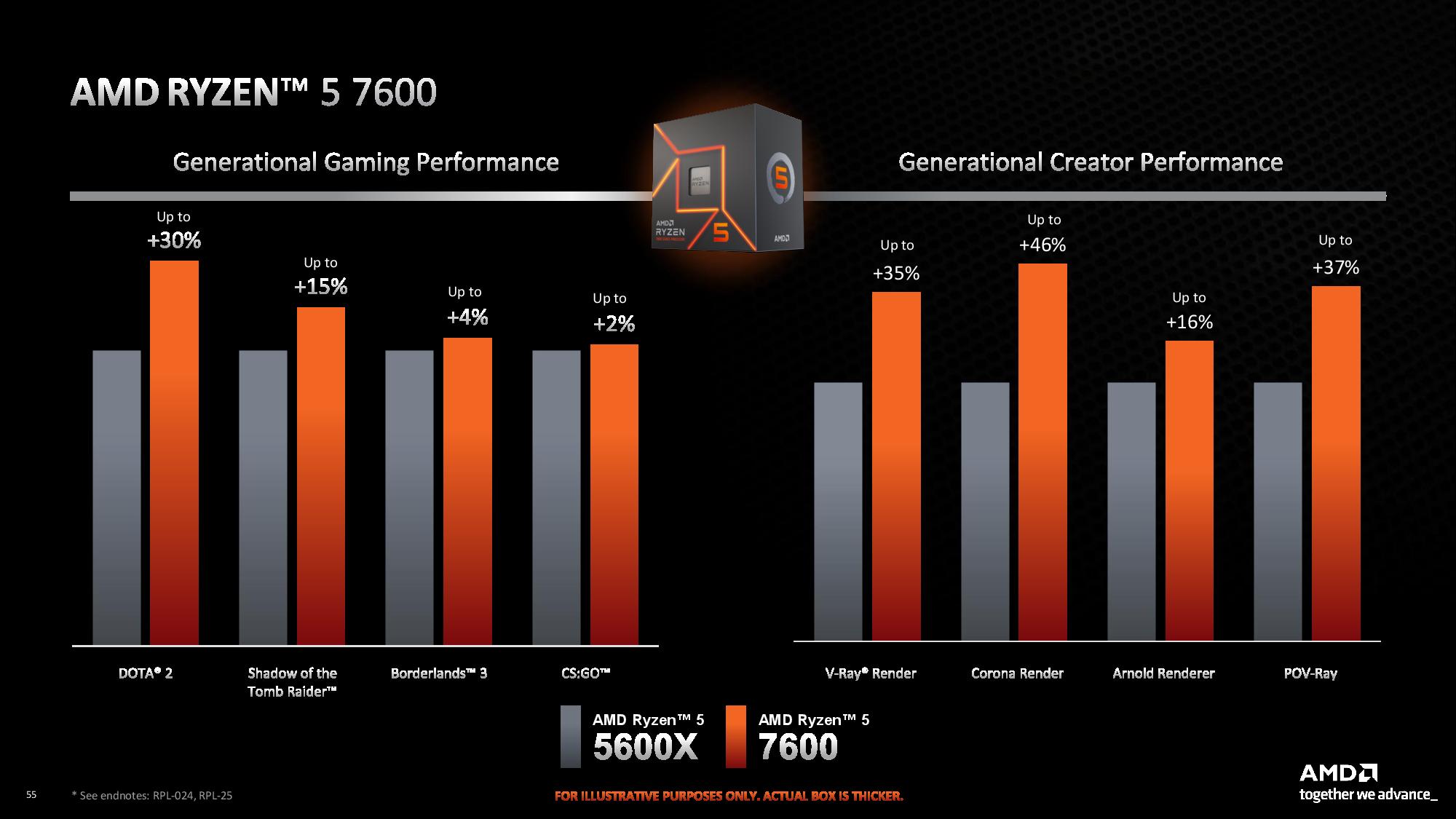
AMD shared its own performance benchmarks for the chips, touting the 7900’s generational uplift of 7% to 31% in gaming and 12% to 48% in applications over the Ryzen 9 5950X. The company also shared similar benchmarks for the Ryzen 7 7700 over the previous-gen Ryzen 7 5800X and the Ryzen 5 7600 over the Ryzen 5 5600X. These are impressive generational uplifts, but the lack of direct comparisons to Intel’s chips leaves some grey area. As you can imagine, reviews will come soon to clear up any lingering performance questions.
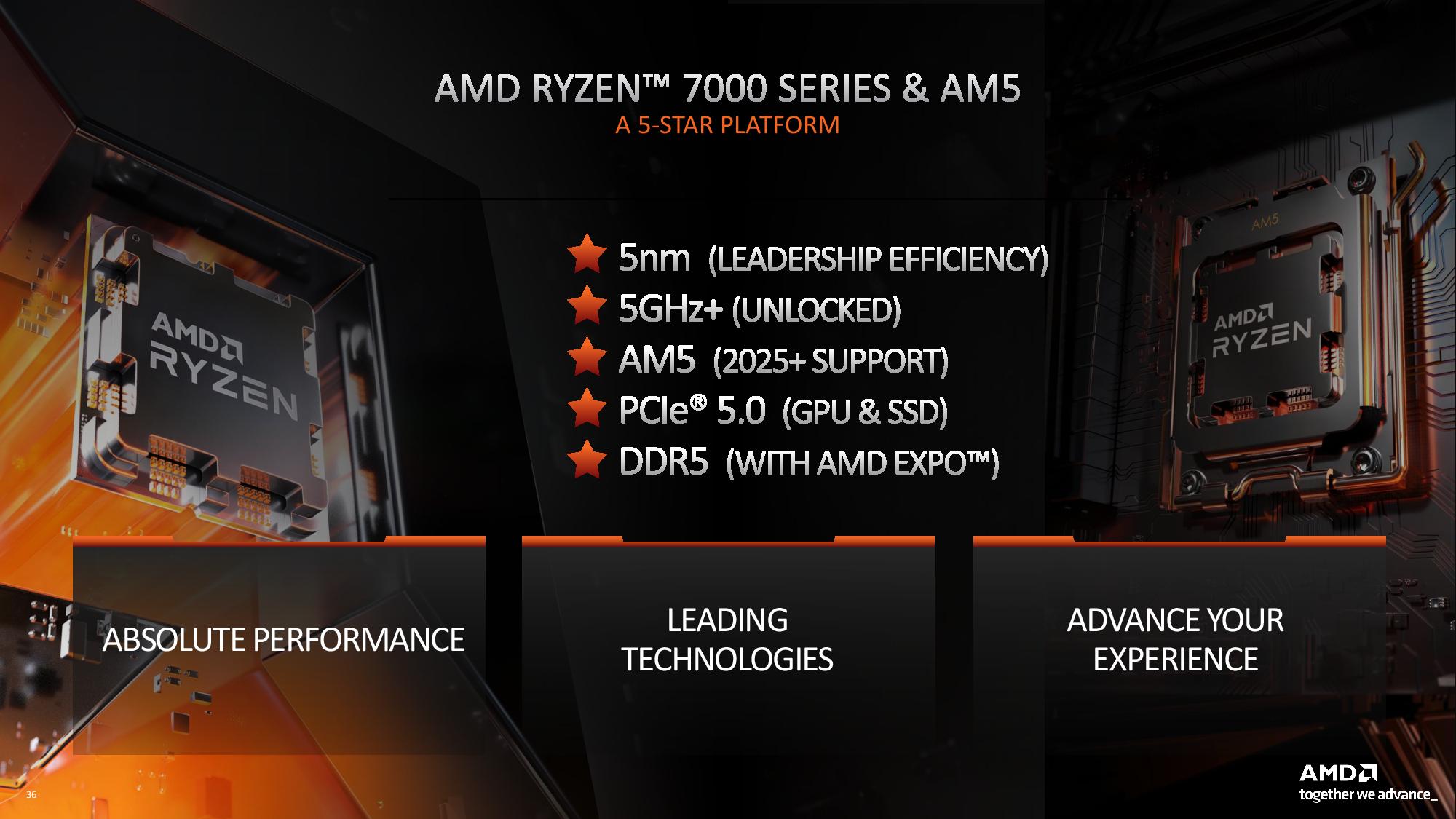
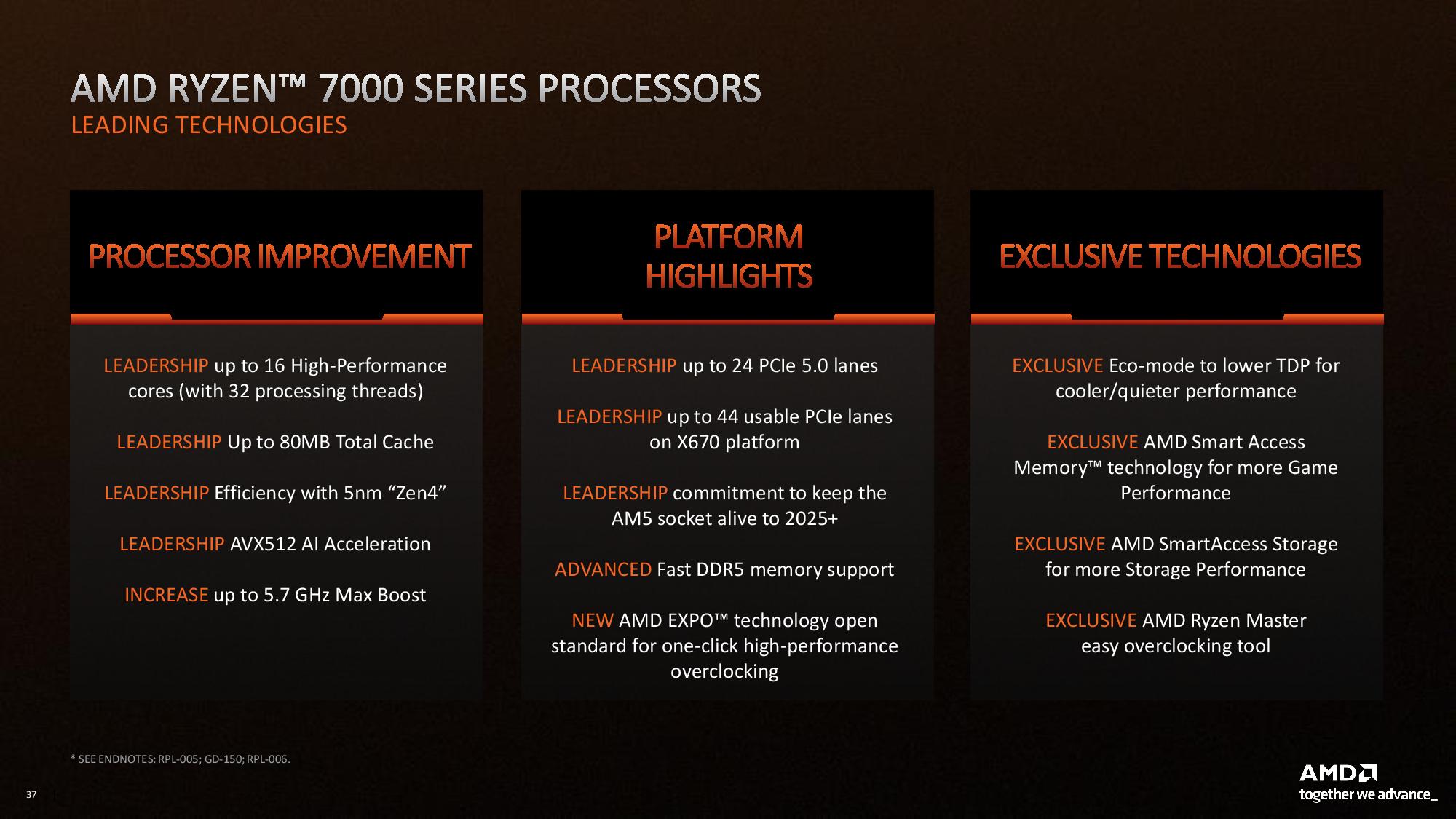
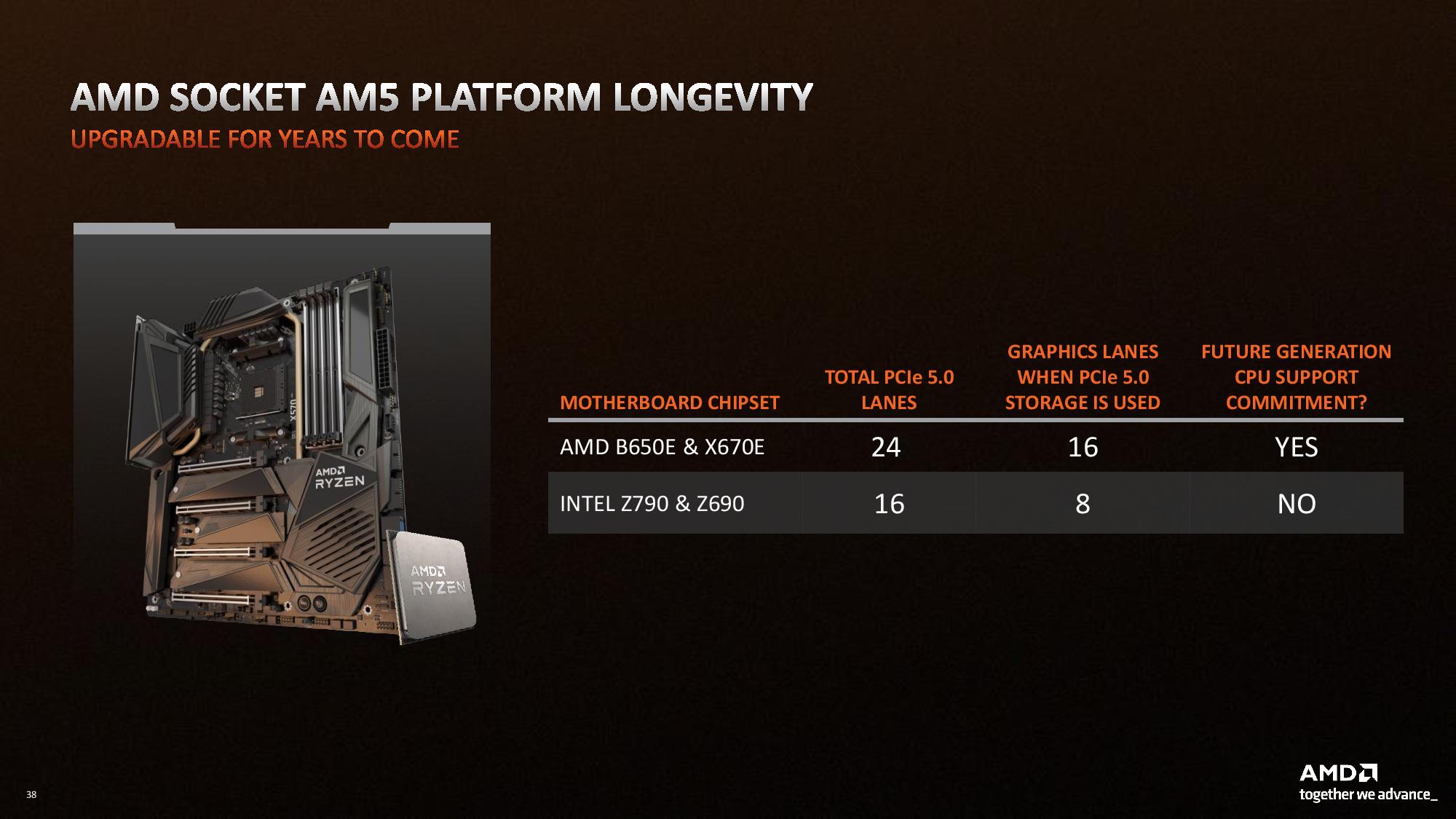
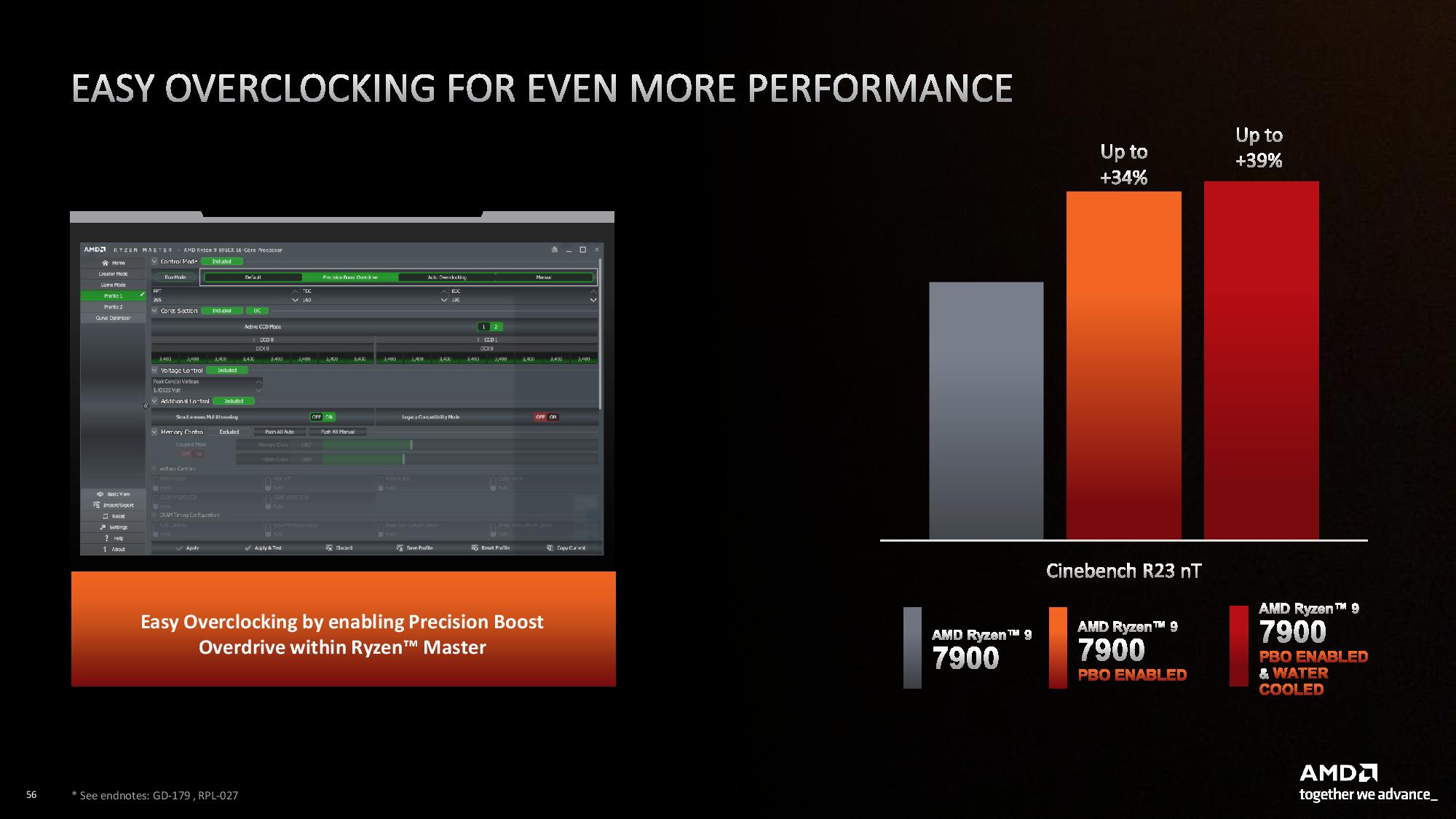
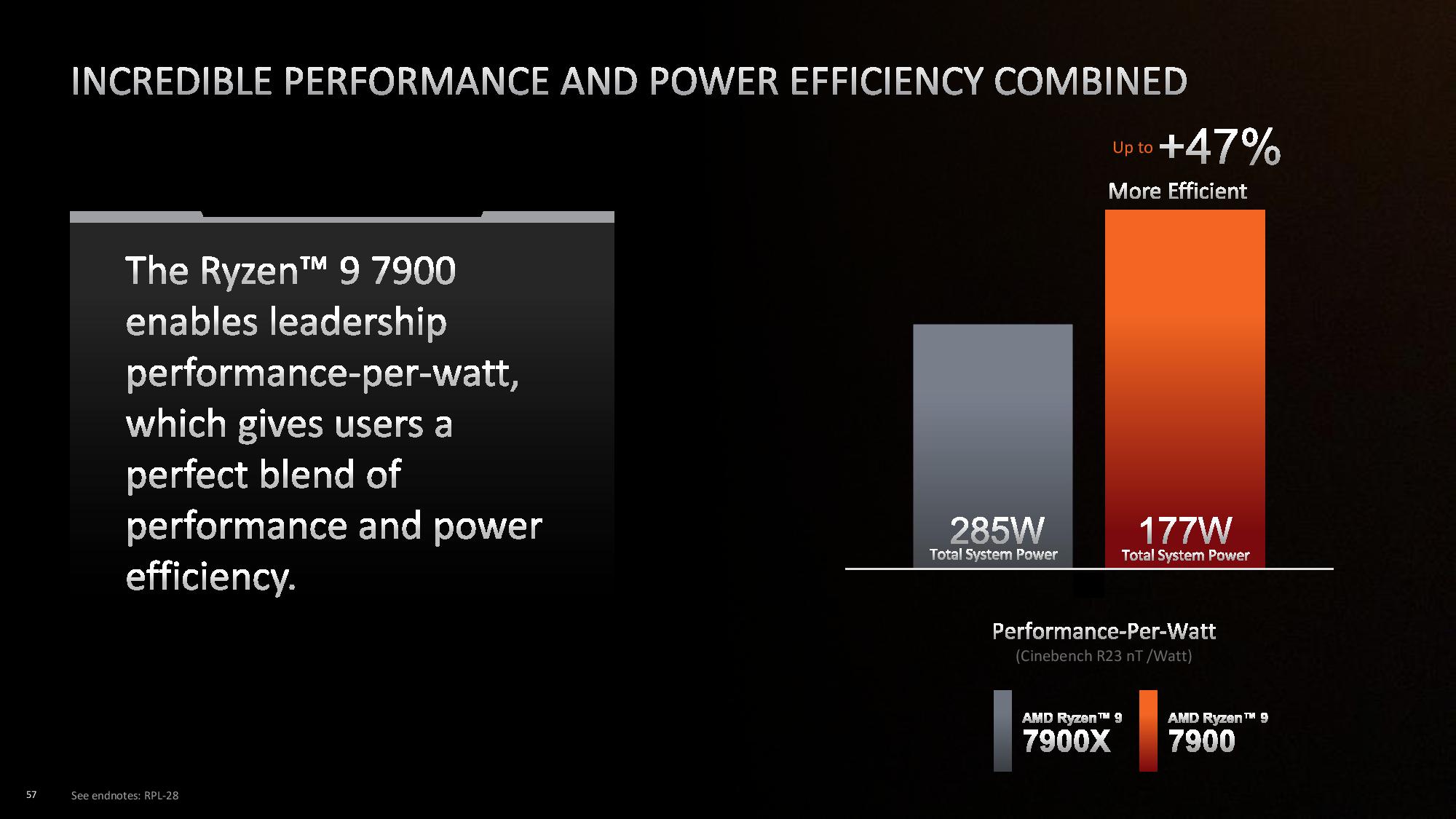
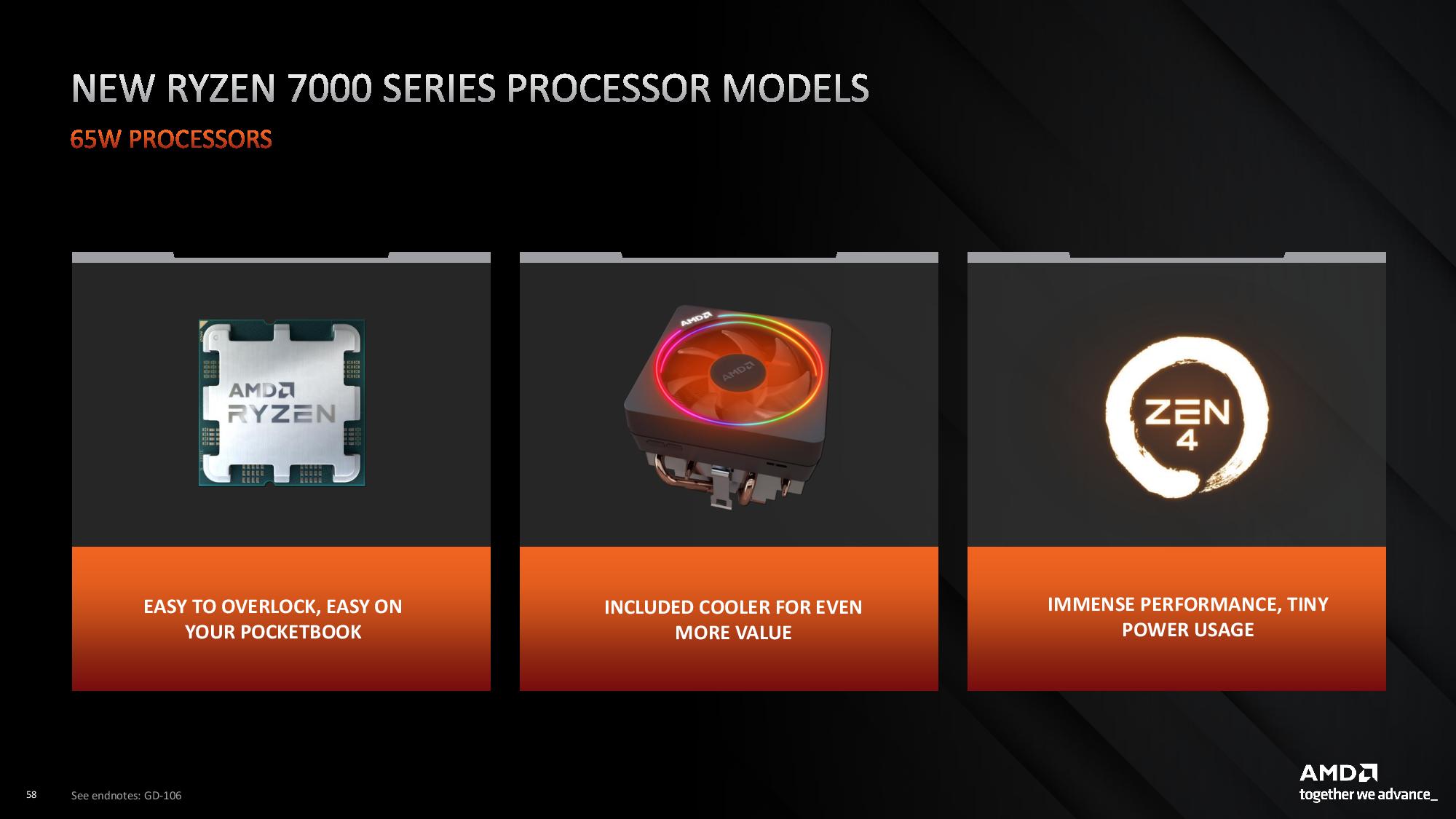
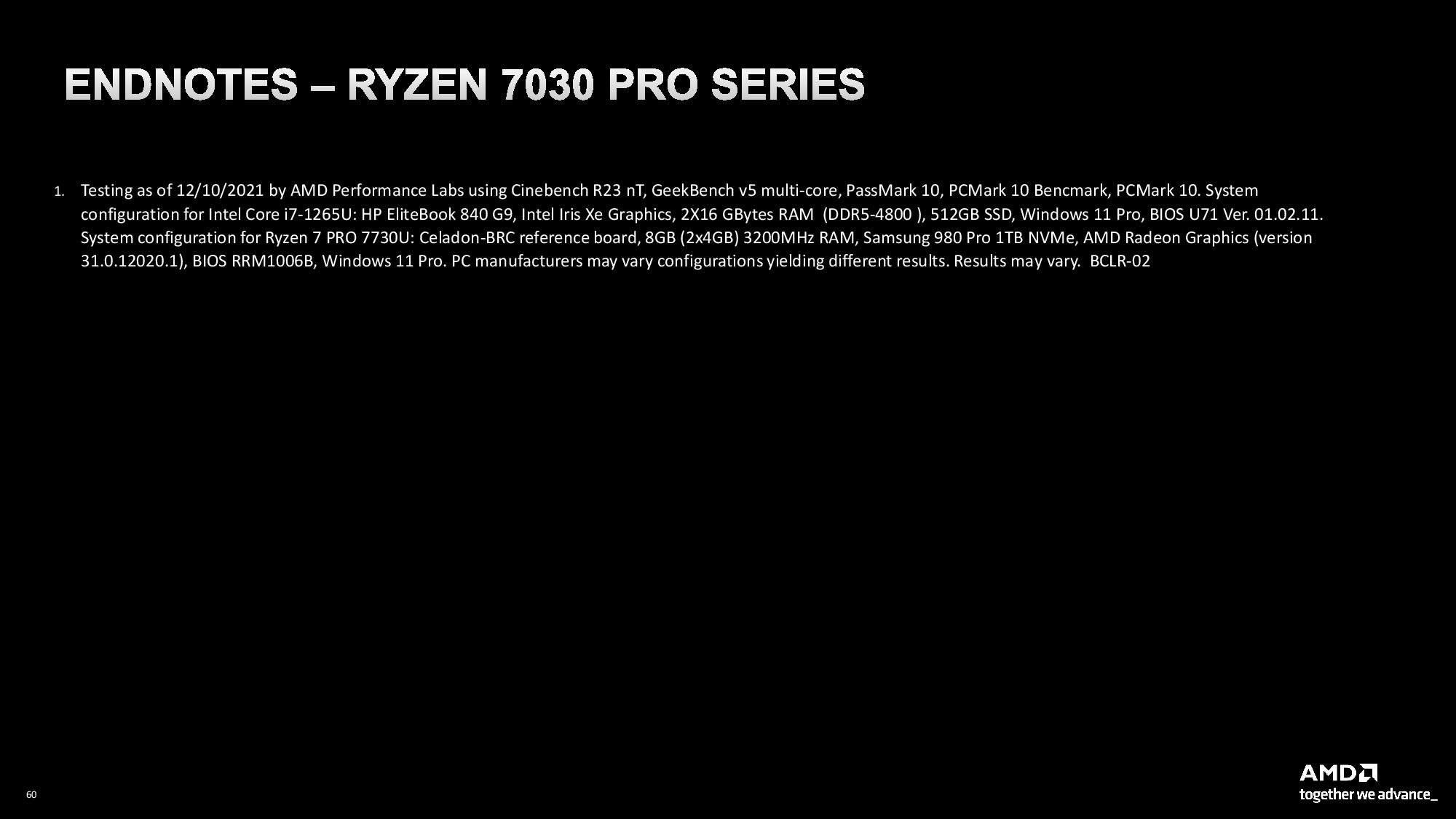
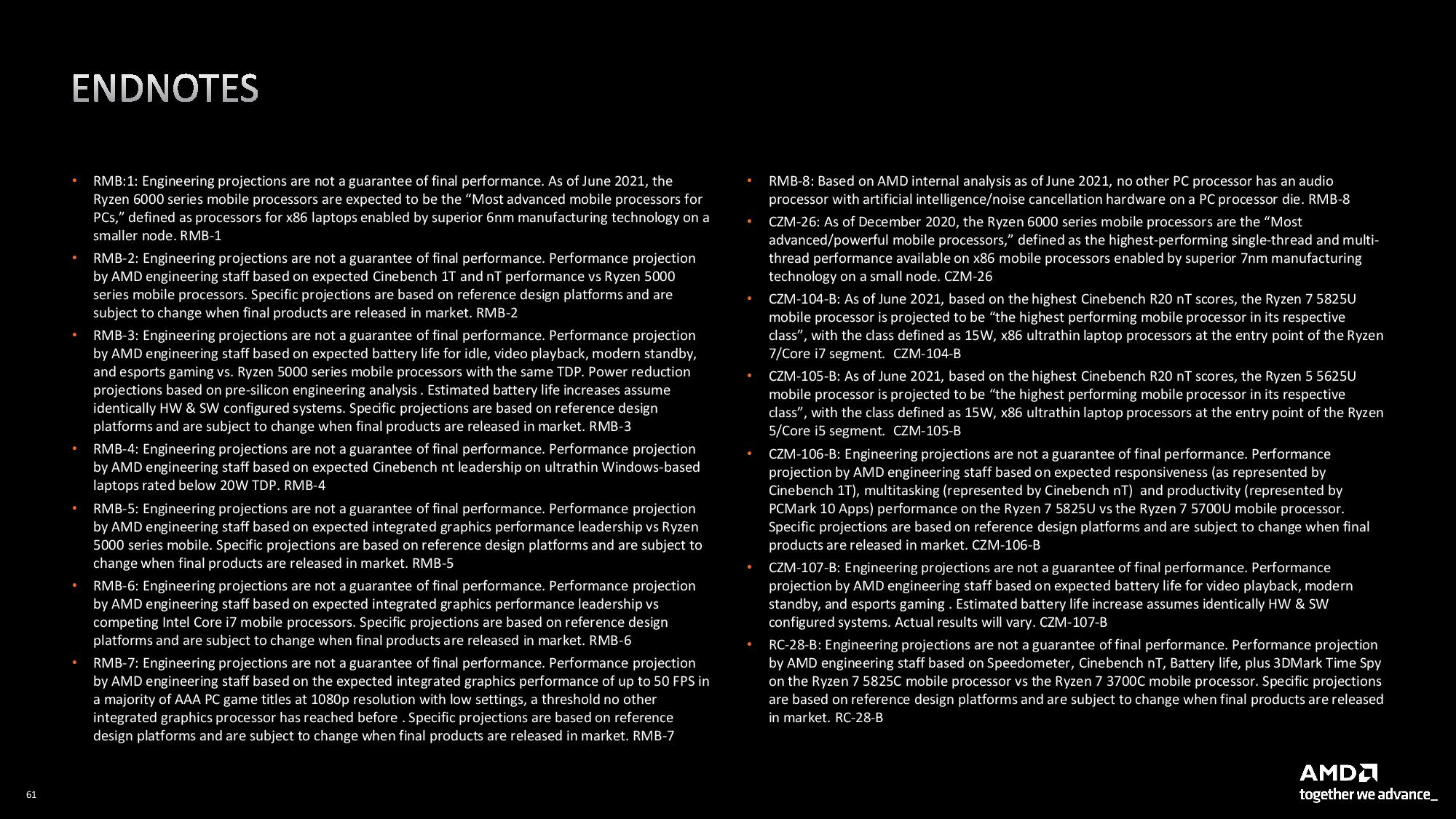
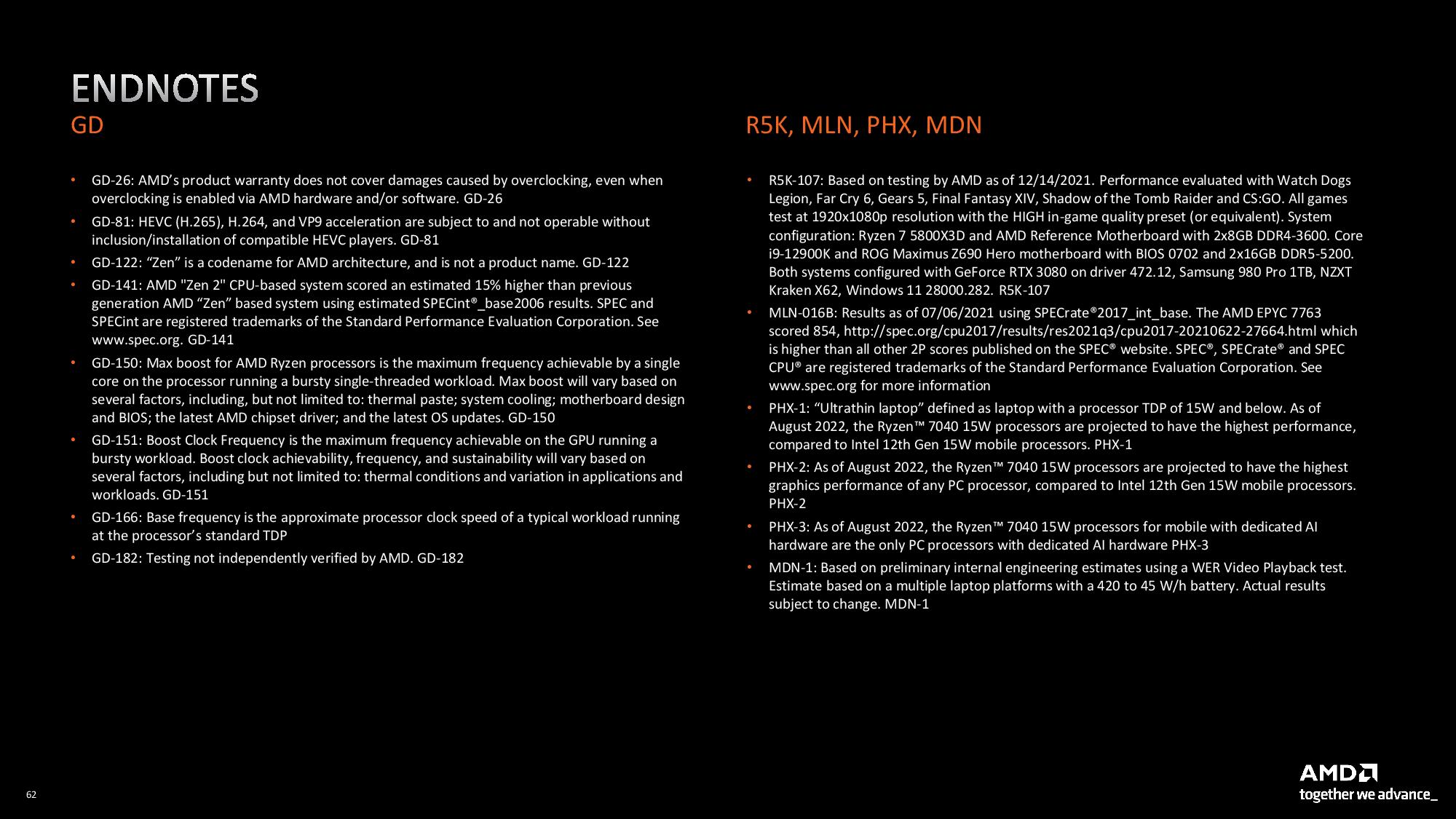
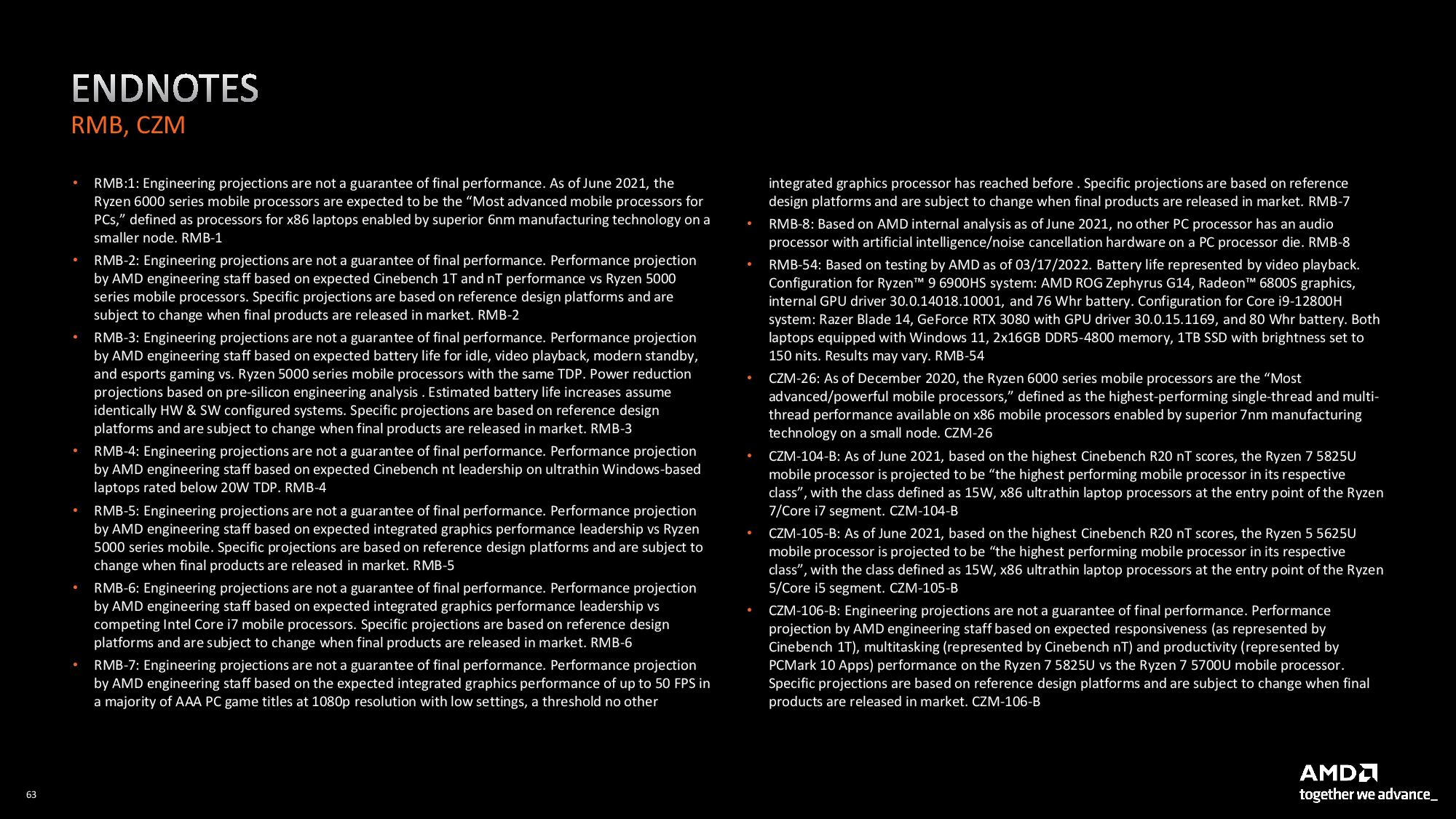
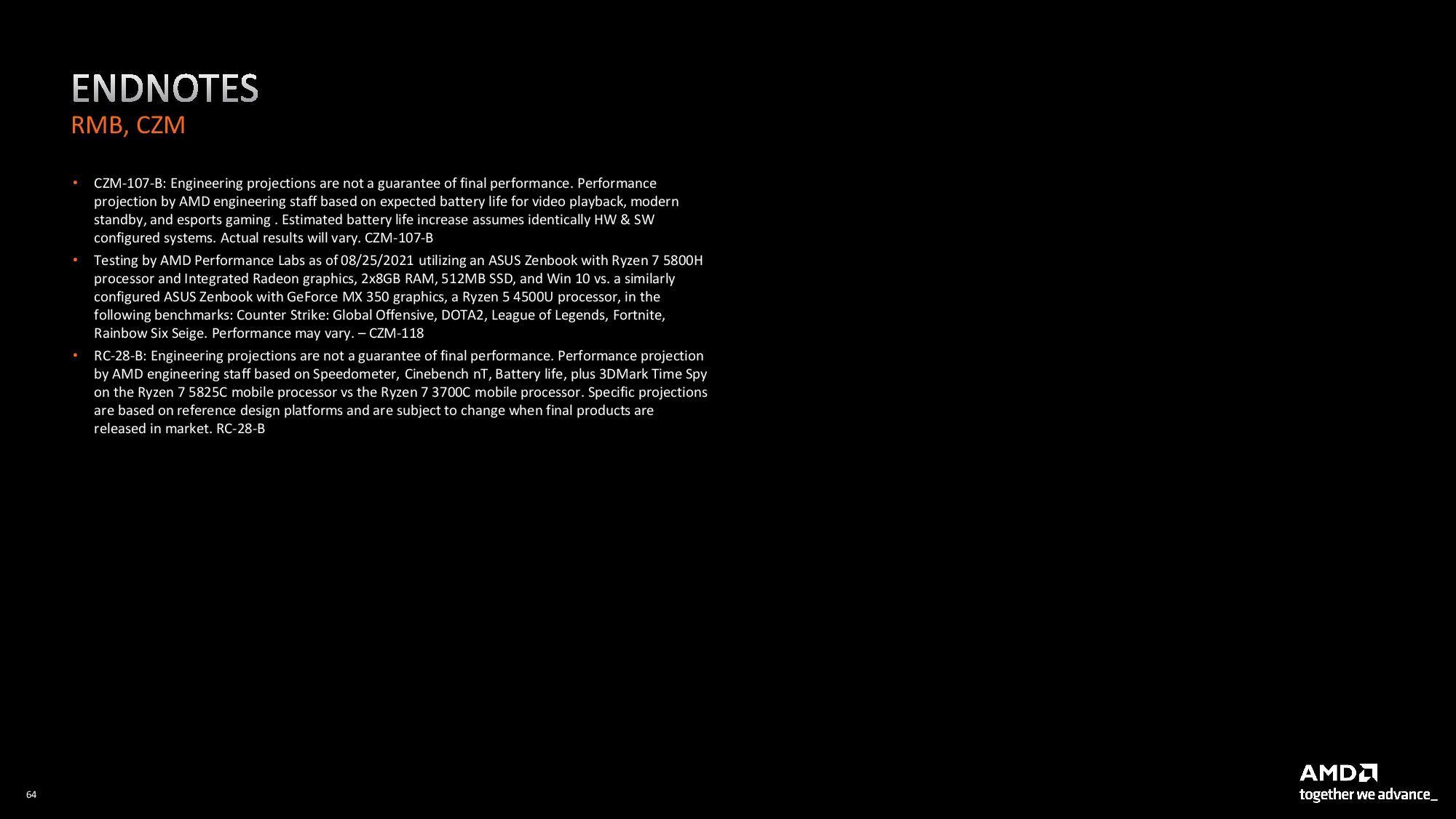
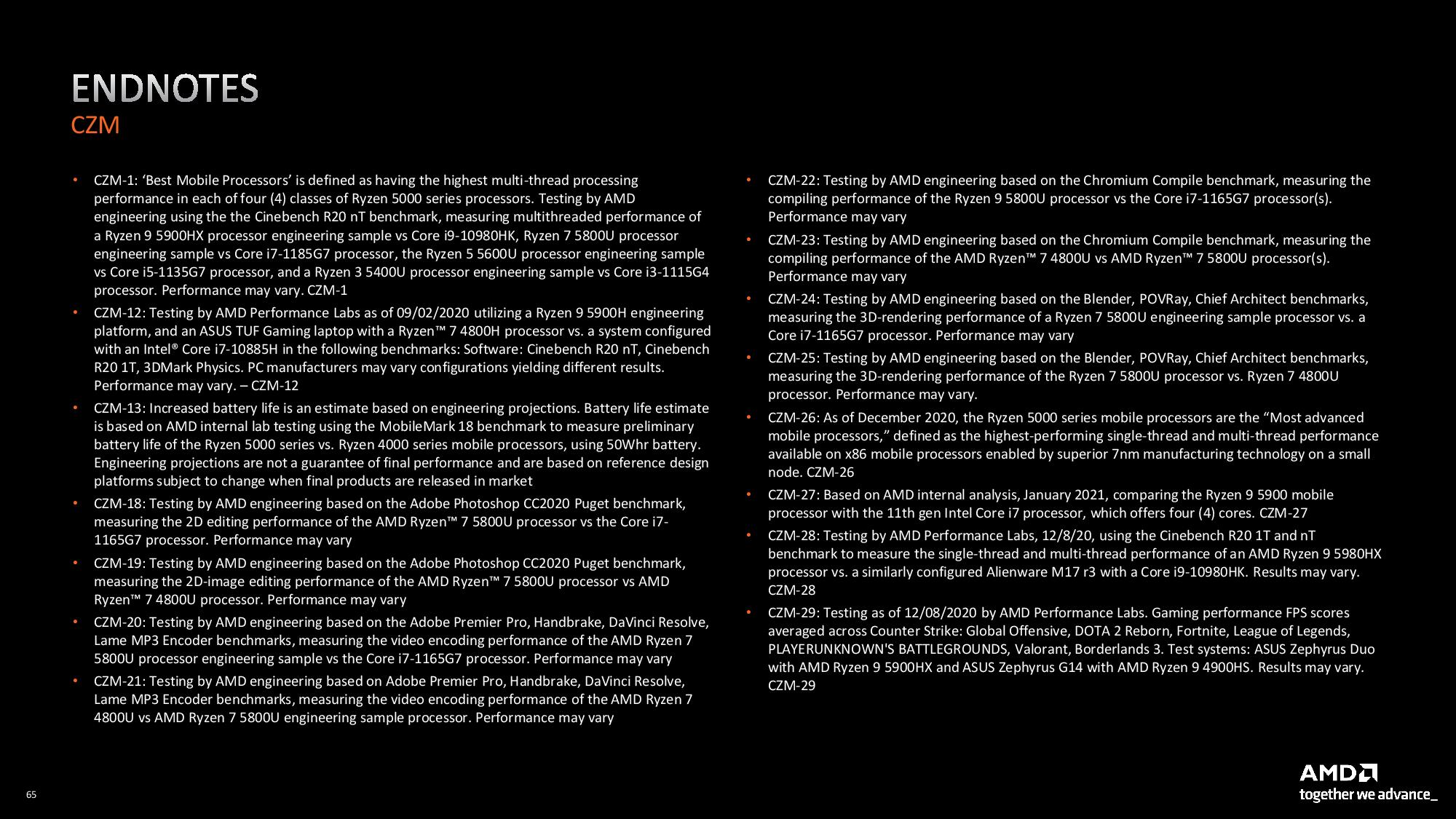
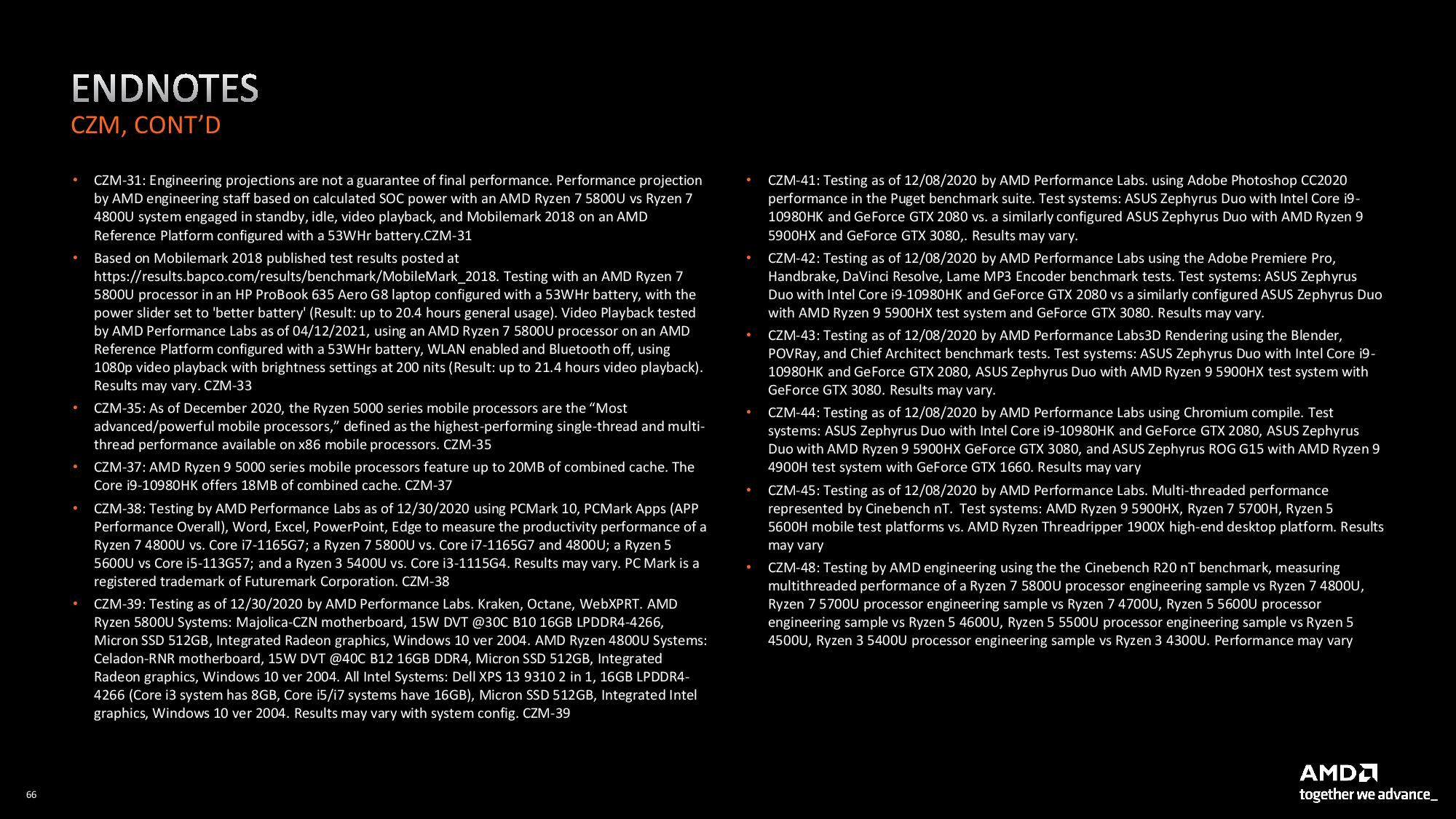
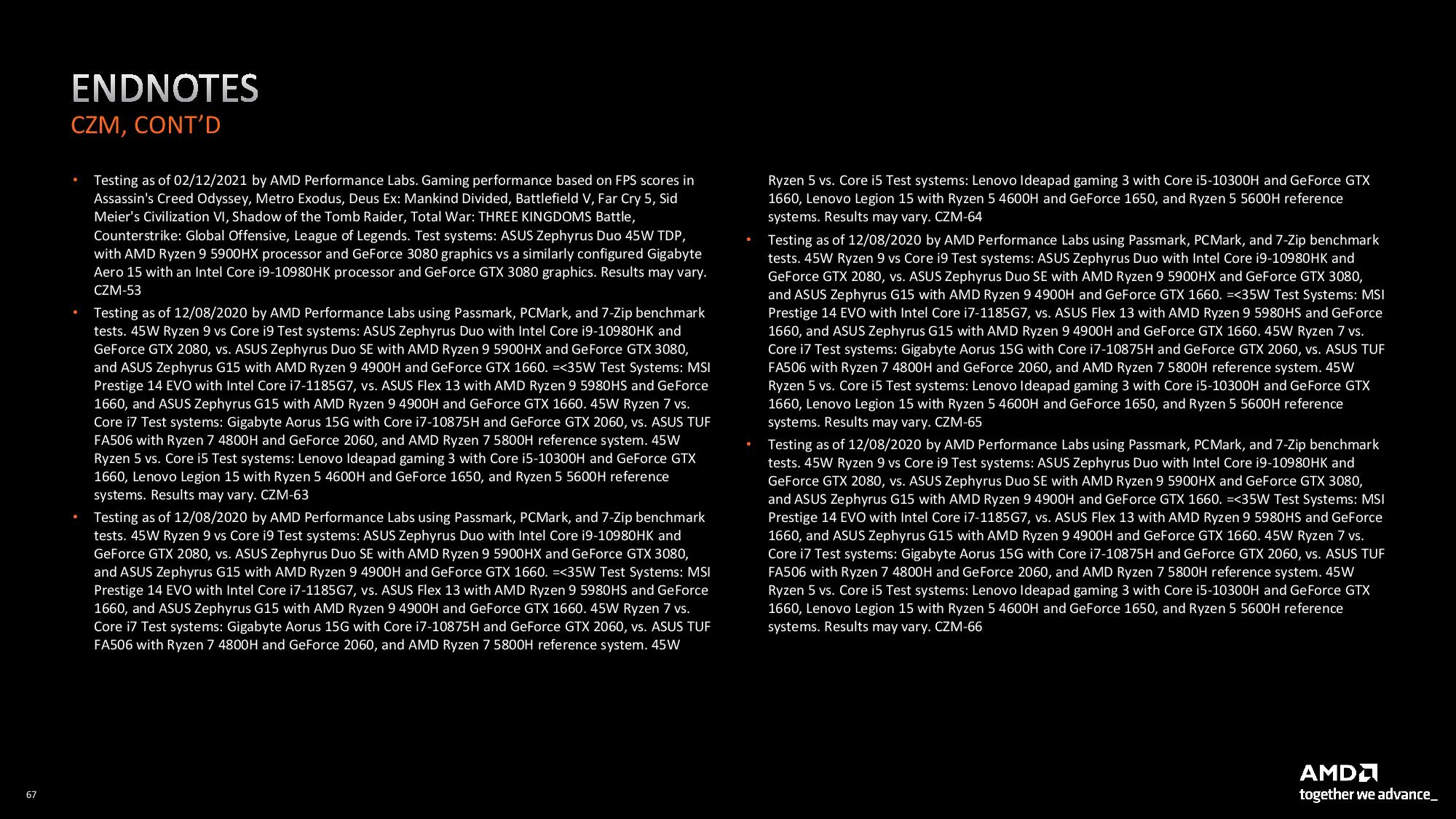
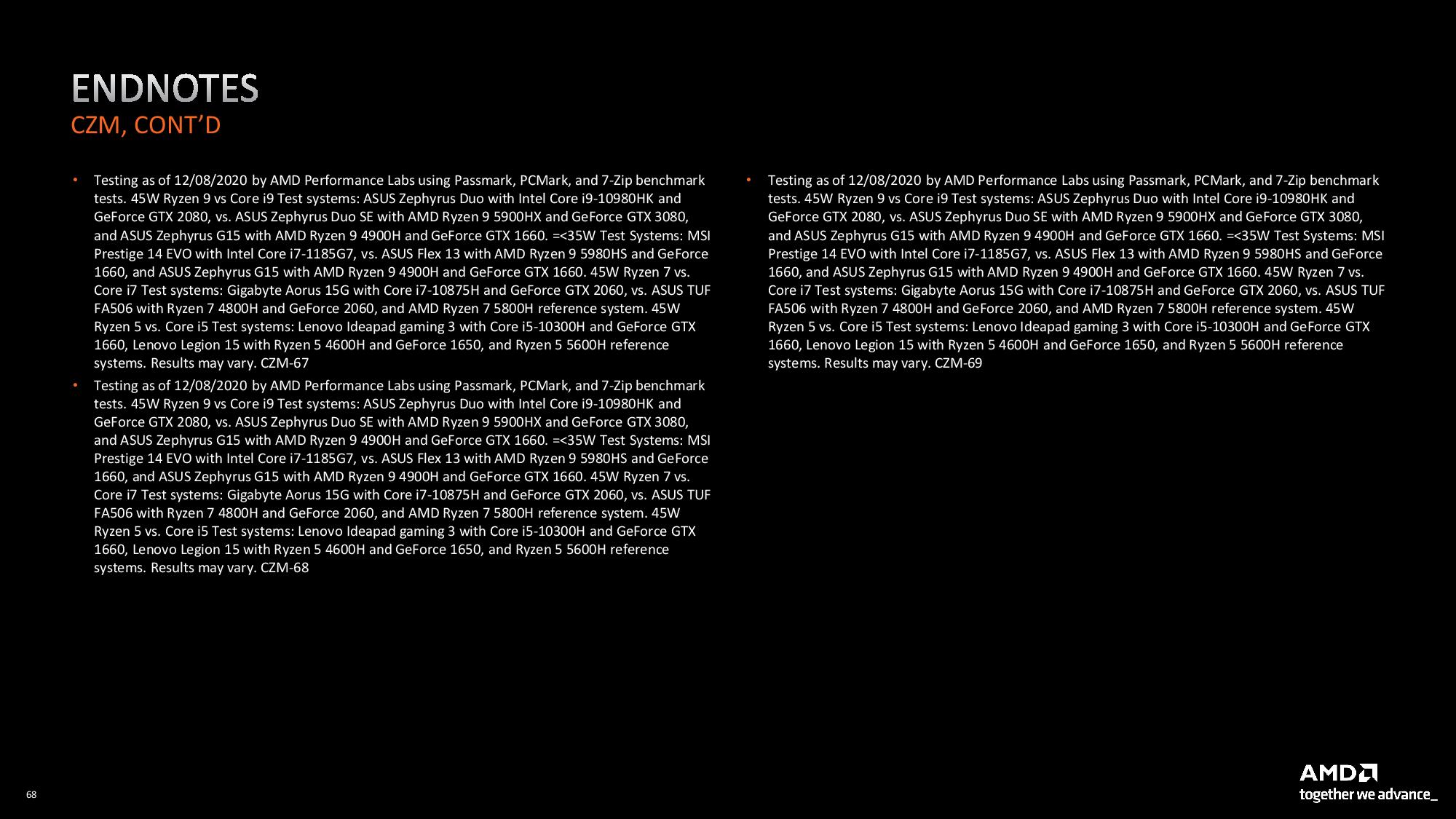
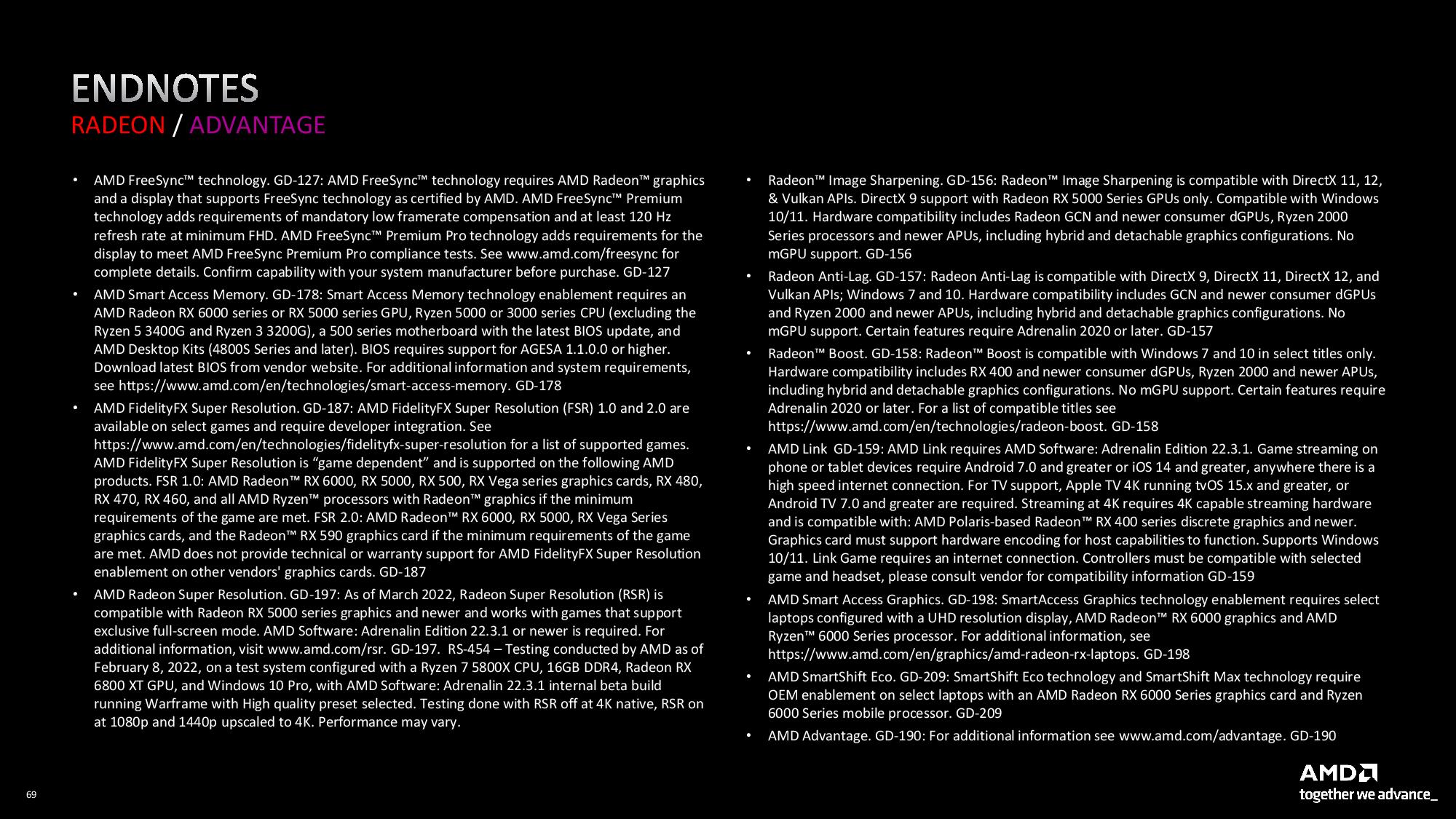
Finally, AMD touted the benefits of its AM5 platform, including a PCIe 5.0 lane count advantage over Intel (24 vs 16) that means your primary graphics card slot will still operate at the full x16 when you use a PCIe 50 M.2 SSD, whereas Intel’s slot will drop to a x8 connection. PCIe 5.0 SSDs are just now coming to market so this may not be a huge advantage now, but AMD has pledged to support the platform to 2025 at a minimum, so it could be more important in the future. AMD also shared a few benchmarks showing a Ryzen 9 7900 yield a 34% gain in threaded work (Cinebench R23) from PBO overclocking with the Wraith Stealth cooler, which increases to a 39% gain with water cooling. The company also shared the obligatory power/performance slide to highlight its generational uplift in performance per watt.

Paul Alcorn is the Editor-in-Chief for Tom's Hardware US. He also writes news and reviews on CPUs, storage, and enterprise hardware.
-
thestryker I really thought that with Zen 5 being a 2024 part that AMD would wait until later this year to release the X3D chips. I'm happy for everyone who was waiting on them and look forward to reading through the reviews to see how much the clocks and TDP impact non-gaming performance.Reply -
PlaneInTheSky ReplyAMD hasn’t shared pricing information for the new X3D chips, but says they will arrive in February.
Never a good sign when a product gets a release date, but the price can not be disclosed.
When you set a release date for a product, it is custom to disclose the price too. -
lmcnabney The X3D chips will be of interest to gamers with fat wallets and want the very best.Reply
The problem is the lack of value in lesser chips. Building Zen4 on PCIe5 and DDR5 has slapped a significant platform cost since the expensive motherboards and DDR5 are not optional. I want to buy AMD, but I don't want to spend hundreds more for equivalent performance. They really didn't think this generation through. -
PlaneInTheSky ReplyThe 65W “non-X” Zen 4 Ryzen models are long awaited by value seekers, as they provide a lower cost of entry to the AM5 platform – a much needed addition given the high cost of AM5 motherboards and the fact that Ryzen 7000 requires pricey DDR5 memory while Intel’s chips can support either DDR4 or DDR5, thus giving it an overall cost advantage.
Let's get real. No "value seeker has long awaited" these. These are still $230+ chips that are only $20 cheaper than their X counterparts. And you would still need to buy expensive DDR5.
Who cares about a $20 discount when you have to throw away your perfectly fine DDR4 and spend $150 buying new DDR5.
Value seekers are buying $100 i3 and using cheap DDR4. A $100 i3 with a $300 RTX 3050 is still a gaming beast of a PC for 1080p.
AMD has no answer to an i3 with DDR4. Forcing people to buy DDR5 was a dumb ass move by AMD. -
lmcnabney Reply
There are two ways to place value. What is the best bang/buck right now and what kind of system will have the longest useful life for the money? A cpu in the 13600k tier can be paired with a 3800 class GPU now and probably get upgraded to a 6800 class in 3-4 years and provide a nice useable life of 7-8 years without being seriously CPU bottlenecked at high resolutions.PlaneInTheSky said:Let's get real. No "value seeker has long awaited" these. These are still $230+ chips that are only $20 cheaper than their X counterparts. And you would still need to buy expensive DDR5.
Value seekers are buying $100 i3 and using cheap DDR4. A $100 i3 with a $300 RTX 3050 is still a gaming beast of a PC for 1080p. -
watzupken Reply
In benchmark numbers, yes. In real life gaming performance, I think it is questionable. Assuming you are using a 5950X now, you should observe in games that most are the cores are at idle. Most games don't scale well with number of cores, which is exactly why Intel Alder Lake and Raptor Lake are able to keep up with the best Zen 4 chips, even with just 8 P-cores in games. Games as I understand don't utilize the E-cores based on the logic in the Windows Thread Director.saunupe1911 said:7950X3D paired with a 4090 is going to be incredible. -
TerryLaze ReplyAs a reminder, AMD’s 3D V-Cache is a revolutionary new tech that 3D-stacks an additional SRAM chip vertically on top of the processor, thus boosting the L3 cache capacity by 64MB and enabling explosive performance gains in gaming (productivity workloads don’t benefit). This tech debuted in AMD’s Ryzen 7 5800X3D, the first ‘X3D’ model, which you can read the deep dive details about here. Intel doesn’t have a comparable technology, though it will soon bring the 6 GHz Core i9-13900KS to market in an attempt to hold onto its gaming crown.
Yeah intel skipped the bad version and went right to having hbm system ram right on the CPU that also works as cache.
It is going to take a while for this to show up in the core lineup for sure though.
https://www.tomshardware.com/news/intel-fires-up-xeon-max-cpus-gpus-to-rival-amd-nvidia64GB of on-package HBM2E memory (four stacks of 16GB) provides a peak bandwidth of around 1TB/s, which translates to ~1.14GB of HBM2E per core at 18.28 GB/s per core. To put the numbers into context, a 56-core Sapphire Rapids processor equipped with eight DDR5-4800 modules gets up to 307.2 GB/s of bandwidth, which means 5.485 GB/s per core. Meanwhile, Xeon Max can use its HBM2E memory in different ways: use it as system memory, which requires no code change; use it as a high-performance cache for DDR5 memory subsystem, which does not require change code; use it as a part of a unified memory pool (HBM flat mode), which involves software optimizations.
